

BUILT TO LAST
An enduring love story for each other — and Iowa State
RUN (THE STUDENT) WAY
The Fashion Show produces leaders who reinvent the textile and clothing industry
FARM, FAIR, AND FAME
Legendary baker Eileen Gannon feels a special connection to the Iowa State Fair










Seasons of Change
When I moved back to Iowa two years ago this July, I was excited to have a true fall season again. I love the tangible shift we experience: the drop in temperatures, the process of unpacking favorite sweaters, the changing of the leaves. You may be thinking right about now, OK great, but it’s mid-summer: why are you waxing poetic about fall? And the answer is because seasons, and fall, represent to me the positives that can come from change, and the word “change” felt ever-present in this issue.
Iowa State University Translational AI Center Director Soumik Sarkar shares plenty of insight around artificial intelligence on pg. 11; one takeaway that I got from our conversation — and I’m taking liberty to paraphrase — was adapt and change with the new technology, or someone else will. In our collaboration piece on pg. 10, the Tiefenthaler family shares the many ways they’ve been able to change and grow their small business thanks to support from Iowa State resources. In our cover story, you’ll learn
that in 1956, C.G. “Turk” Therkildsen and Joyce McEwen had their first date at the Memorial Union for Coca-Colas. Today, Iowa State is a Pepsi campus. Change!
Change is constant, for better or worse. Personally, I like to focus on the better — to see the new opportunities change can bring. And that brings me to the most significant changes you’ll learn about in this issue: an update to ISU leadership (pg. 6) and a message from Iowa State President Wendy Wintersteen (’88) regarding the future of the ISU Alumni Association and ISU Foundation — and what opportunities are on the horizon (pg. 30).
And two months from now, summer will change to fall — and fall on the Iowa State campus is a wonder to behold.

Iowa Stater
Editor Kirsten Kraklio
Assistant Editor Caleb Grizzle
Designer Jenny Witte
Photographers Christopher Gannon, Matt Van Winkle, Isaac Farner
Creative Consultant
2communiqué
Editorial Board
Kirsten Kraklio, Director of Communications, ISU Alumni Association
Brian Meyer, Associate Director for Strategic Communications, Iowa State University
Sherry Speikers, Director of Editorial Services, ISU Foundation
Postmaster: Send address changes to Iowa Stater, ISU Alumni Center, 429 Alumni Lane, Ames, IA 50011-1403
Copyright 2024 by the ISU Alumni Association, Jeffery W. Johnson, Lora and Russ Talbot Endowed President and CEO
Iowa State University does not discriminate on the basis of race, color, age, ethnicity, religion, national origin, pregnancy, sexual orientation, genetic information, sex, marital status, disability, or status as a U.S. veteran. Inquiries can be directed to the Office of Equal Opportunity and Compliance, 3280 Beardshear Hall, 515-294-7612.
GET IN TOUCH WITH US!
ISU Alumni Association
ISU Alumni Center 429 Alumni Lane Ames, IA 50011-1403
iowastater@iastate.edu 1-877-ISU-ALUM (478-2586)






TOP: For the past 20 years, a group of alumnae — some who were part of the first ISU softball team in 1971 — have reunited each spring for a softball game and each fall for a football game. Attendees include: “DL” Metheney (’74), Diane (Miller) Kingsbury (’75), Sandy (Rickert) Moore (’75), Deanna “Jack” (Dempsey) Drake, Johanna Baedke (’77), Chris Green (’74), Jan Doschadis (’74), Sherry (Meinecke) Aschbrenner (’71), Kathleen (Proescholdt) Goodman (’74). BOTTOM: Cyclone fans Tony Pelham, Monte Bonnicksen (’75, ’84), Susan Bonnicksen (’78), Karen Goldsworth (’95), Randy Pelham (’73), Sheena Nuetzman, Jen Boldt, Shaun Goldsworth, and Matt Nuetzman (’05) gathered in Guanacaste, Costa Rica to cheer on ISU in the Big 12 Football Championship.
LETTER TO THE EDITOR
“Enjoyed the article “Before Alexa, There was Mary.” A small group of us came up with the idea of AnswerLine and we had no idea how lasting it might be even as technology evolved. The purpose was to supplement and complement the engaging work of the local Extension staff. Initially, staff had concerns that it would reduce their interactions with people in their communities. Before long, it was obvious that the purpose was being achieved. This was due to the outstanding work of our first employee, Mary Jo Williams (‘78). She not only responded to the questions but referred callers back to the local office.”

Email iowastater@iastate.edu. Your submission may be shared in print or online.
CAROL L. ANDERSON (’76)

Vibrant blooms can be found above and below as students walk together on campus near The Hub.
Image by Christopher Gannon

FOREVER TRUE FOR ISU: PRESIDENT WENDY WINTERSTEEN TO RETIRE IN 2026
Iowa State University President Wendy Wintersteen has announced her plans to retire in January 2026. Wintersteen became the first woman and second ISU alum to hold the university’s highest office when she was named the 16th president of Iowa State in 2017.
“I am fortunate to have served Iowa State University in many roles over the past 46 years, and it’s been a fascinating journey,” Wintersteen says. “I am truly proud of Iowa State’s extraordinary faculty and staff for their remarkable performance these past years. Perhaps most of all, I will miss the amazing energy, talent, and potential of our Iowa State students.”
President Wintersteen’s tenure has been marked by new and renovated facilities across campus, record research grants, and awards for innovation, significant improvements in student outcomes, a significant expansion in the ISU Research Park, and strong fundraising success.
Raj Agnihotri to Lead Ivy College of Business
Raj Agnihotri has been named the next Raisbeck Endowed Dean of Iowa State University’s Debbie and Jerry Ivy College of Business; his service began July 1.
Agnihotri previously served in the college as the Mary Warner Professor and Morrill Professor of marketing and assistant dean for industry engagement.
“Dr. Agnihotri is an accomplished researcher and student-centric leader. He has the experience and vision to advance business education and strengthen our entrepreneurship and innovation ecosystem to benefit Iowa’s economy,” says ISU President Wendy Wintersteen. “I am confident he will continue elevating the reputation of the Ivy College of Business, both nationally and globally, and build on the excellent momentum created by Dean David Spalding.”

DID YOU KNOW?
Iowa’s Small Business Development Center supported 5,017 Iowa companies in fiscal year 2024. Those businesses accounted for more than $56 million in new capital, including the creation of 1,202 jobs and 156 businesses.



Researcher’s Work to
PIT STOPS IN IOWA PRECEDE NONSTOP FLIGHTS TO SOUTH AMERICA, BIRD-TRACKING STUDY SHOWS
Nonstop flights direct from Iowa to Venezuela are rare, unless you happen to be a well-fed pectoral sandpiper. Pectoral sandpipers are the most common long-distance migratory shorebirds seen in Iowa, which is a convenient stopping point between their Arctic breeding grounds and their winter home in South America. Recent research by Iowa State ecologists found that if a pectoral sandpiper finds plentiful resources to refuel, Iowa can be its last stop before a continuous flight of around four days covering thousands of miles.
Support New Moms Leads to ISU’s First-Ever Apparel Design Patent
Li “Lily” Jiang, a PhD student in apparel design, and Ling Zhang (’08, ’16), an associate professor in apparel, events and hospitality management, received an apparel design patent last fall for their multi-layered maternity garment, marking ISU’s first-ever patent in that category.
Zhang’s startup company, MUQIN (which means “mother” in Mandarin), currently offers a fit-adjustable nursing bra and a nursing babydoll featuring the patented design.
“It’s exciting to hear from women who have purchased our fit-adjustable products and love wearing them,” Zhang says. “We get to see our work making a difference.”


EXPERIENCE
Fire and Glass
IOWA STATE’S GLASSBLOWING CLUB HAS MADE AN IMPACT ON STUDENTS, ALUMNI FOR MORE THAN 50 YEARS BY
MIKE KRAPFL
JAYCE ABENS, FINGERS WORKING TO SPIN A 5-FOOT METAL PIPE, gathers molten glass from the orange-hot tank furnace in the studio of Iowa State’s glassblowing club, the Gaffer’s Guild.
“You can see the honey consistency,” Abens says as he holds up the glowing lump at the end of the pipe. Then he works the soft glass, rolling it across a steel table called a marver, smoothing, shaping, and cooling the lump into what will become a curvy vase.
Working with glass is “a combination of science and engineering and art,” says Abens, a senior mechanical engineering and MBA student from Webster City, Iowa. “It’s a cool outlet outside of engineering to be creative.”
Growing and Thriving
The Gaffer’s Guild has been on campus since 1972. Its humble and homemade history includes blowing glass outdoors and in two now-demolished buildings, the Engineering Annex and Old Sweeney Hall. The club was without a home and furnace for about five years until fall 2020 when it relocated to just inside the west doors of the Student Innovation Center. The orange glow from the professional-grade furnaces can be seen from the street through the studio’s windows.
“We’re back,” says Steve Martin, a University Professor, an Anson Marston Distinguished Professor in Engineering, and the Gaffer’s Guild adviser. “This is a world-class facility.”
Students can access the facility for $120 per semester and completion of a beginner’s class. (The club is also open to faculty, staff, and community members who pay a higher fee.)
“We train them for six to seven weeks, and then give them the keys to the car,” Martin says. “They can come in with a buddy and blow glass.”
Glass That Gives and Gives Back
Alumni say the club has influenced careers, taught leadership, and encouraged service. Some return to teach workshops and help around the studio.
Randilynn Christensen, who has undergraduate degrees in music and physics (’07) and a doctorate in materials science and engineering (’12), says glass and the Gaffer’s Guild has “fundamentally altered my life.”
She learned about the club her junior year when she stopped at a craft sale in the Memorial Union. She had made pottery in high school and “wanted to do something with fire and glass.”
“Wow, we have a glassblowing club,” she remembers
Students, staff, faculty, and community members can join Iowa State’s glassblowing club to create art for themselves or the university.

thinking. “This is my dream.”
She joined, soon became treasurer and made regular reports to Martin. When she was struggling to find a graduate program in physics, Martin encouraged her to try engineering and invited her to join his research group and study glassy materials to develop better batteries. She now works for 3M in Minneapolis, where she manages projects that use artificial intelligence tools for materials development.
She’s still a hobbyist — she’s helped lead a nonprofit glass arts studio — but mostly works with stained glass these days.
Keith Kutz, who has bachelor’s and master’s degrees in
geology (’83, ’87) and now works on campus as a grants administrator, discovered the club during a campus demonstration in 1997.
Now he helps keep the studio running and encourages students to give back by making presentations to children on field trips or by creating special pieces as university awards.
His point of pride about the Gaffer’s Guild?
“This has been a student-run club for almost 53 years now,” he says. “For us to not only survive, but actually thrive and grow, is a testament to the art form itself and to the innovation of our students. They’re pushing the envelope here.”
COLLABORATION
Recipe For Success
A KEY INGREDIENT TO TIEFENTHALER’S GROWTH AND AWARD-WINNING BRATS: IOWA STATE BY ANGIE HUNT
THERE WAS LITTLE QUESTION about where Jordan Bremer would continue her education after graduating from high school.
“I already had a job at the Meat Lab, before I even had my acceptance to Iowa State,” Bremer (’15) says. “It was just an easy decision. I knew I had the Meat Lab, and I knew that it was like a second home.”
Growing up in her family’s business gave Bremer an early introduction to Iowa State University. Her father, John Tiefenthaler, has worked closely with ISU experts through short courses offered by the Meats Laboratory and more recently with the Center for Industrial Research and Service (CIRAS) to develop a succession plan for Tiefenthaler Quality Meats in Holstein, Iowa.
The Meat Lab is known for its short courses, which cover everything from snack sticks to curing hams to fresh cuts of beef and pork. Matthew Wenger,
training and outreach coordinator, says they’ve built a reputation as a trusted partner for meat processors of all sizes, in Iowa and globally.
“The mission of the land-grant institution of extension is to take the information to the people, and that’s what we’re doing day in and day out,” Wenger (’00) says.
Known for its skinless brats, Tiefenthaler Quality Meats expanded to include a smokehouse, retail shop, and wholesale for around 90 Iowa grocery stores. During his 30-plus years in business, Tiefenthaler has relied on the Meat Lab to help him manage growth and provide quality products.
“I learned as I went, and that’s where Iowa State was huge,” Tiefenthaler says.
As the family business moves to the next generation, Tiefenthaler says having CIRAS as a partner has made all the difference.
“All the support and wisdom they
gave us, we took it and we ran with it,” he says. “I don’t know if they know how much of an impact they’ve had, because everything we’ve come up with out of all those meetings has resulted in 100% following through. It’s happening.”
Bremer is confident in taking over the family business because of the knowledge and experience she gained as a student and knowing the support the university provides for small businesses. It means a lot to continue serving their community.
“There’s a lot of pride knowing that you were able to create something that everybody loves,” Bremer says. “It’s just another way to prove to myself that I’m where I need to be and doing what I need to be doing.”
Read more of the Innovation at Work series to learn how Iowa State is a trusted partner for innovative and proactive solutions: news.iastate.edu/innovation-work.

From left: Jesse and Jordan Bremer and Austin (’16) and Courtney Tiefenthaler are ready for the next generation of Tiefenthaler Quality Meats thanks to their collaboration with Iowa State.
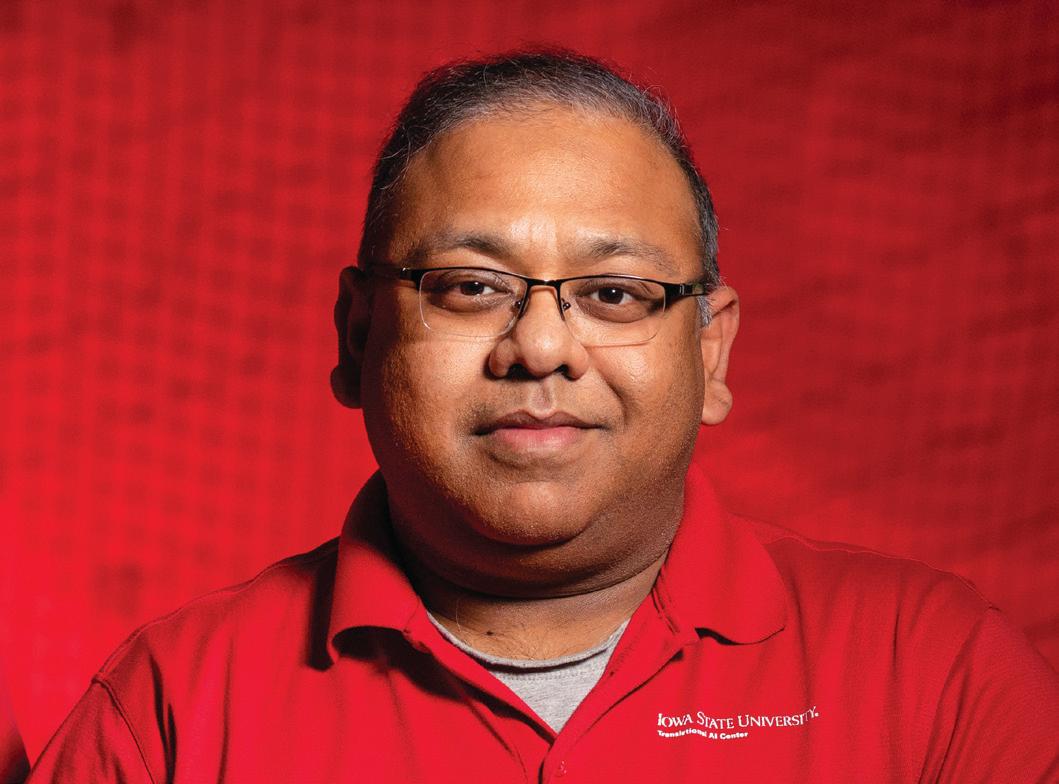
UNDERSTANDING
Making the Most of Machine Learning
ISU DIRECTOR SHARES ABOUT AI RESEARCH, TIPS, AND TOOLS
BY KIRSTEN KRAKLIO
FOR THREE YEARS, Iowa State University’s Translational AI Center (TrAC) has been the center of artificial intelligence (AI) research at the university.
Soumik Sarkar, director of the center and associate director of the AI Institute for Resilient Agriculture, says the center’s goal is to get AI research applied, commercialized, and translated into practice.
“We also want to help the Midwest get ready for an AI future — upskilling and reskilling the workforce, and general awareness,” Sarkar says.
Sarkar answered a few questions about TrAC, and the use, tools, and detection of AI.
What does TrAC do at Iowa State?
We mainly do three things. One is AI plus X research, which means core AI research as well as AI applied to different sectors. That could include agriculture, manufacturing, transportation, healthcare, and so on. Number two is AI plus X training. Throughout the year, we run a lot of tutorials, workshops, research seminars, bootcamps, and micro credentials, both for Iowa State audiences and the general public. The third thing is AI plus X workforce, which means that we are training a lot of undergraduate and graduate students within Iowa State who are going out to different companies or starting their own businesses that have AI as a core element.
How does the center navigate concerns and controversies around the use of AI?
It’s a controversial topic. Within our center, we have AI ethics as a separate area dedicated just for these conversations. We collaborate with social sciences faculty members who are trained to think about ethical implications, social dynamics, and social science context with folks like myself — AI engineers and computer scientists — who have the technical know-how.
But of course, we are not policymakers. The fact is AI is going to change the nature of our jobs, our work across the board as educators from university professors to kindergarten teachers. It’s going to change how we do things for all of us. Now, if we own this and we try to stay ahead of the curve and actively figure out how to leverage it and become a user of these tools rather than a competitor, the better off we’ll be, right? It’s becoming a cliché to say this, but I still feel that it’s true: You’re not going to be replaced by AI, but you’re going to be replaced by people who will use AI better than you.
How would you recommend people start using AI if they want to get familiar with it?
I feel like right now, tools wise, writing is the most advanced. The email provider you use likely has an AI tool to help you write or complete your emails. Then moving from that if you’re writing a blog post or you’re building your resume, you can use AI tools to get a first draft. Or another interesting way to use it is to write something and then ask an AI tool: “What do you get out of this? Can you summarize this?” That allows you to check whether what you think you are trying to communicate is the same as how the AI tool is understanding your text; you can use it as a writing buddy. Another way you can use it is for office task management — organizing calendars, summarizing meeting notes, etc. Just remember: you ultimately have to review whatever you generate from AI, you cannot completely rely on AI alone.
How can people identify AI-generated photos?
If a photo is too glossy, too perfect, very smooth. Look at textures and details of any extremities — hands, fingers, there is going to be a little wiggle or maybe there’s symmetry issues. Images also might be a little bit cartoony in some cases. These are all possible clues that something is AI generated. But the thing is, AI is getting better every day, so whatever I just said may be wrong soon. In six months, you may not see those clues. There are also a lot of AI generation detectors coming out; these tools aren’t 100% accurate, but most of them can catch if something is AI generated.
Ready to test your abilities to identify AI-generated photos? Head to iowastater.iastate.edu to take our quiz.

IMPACT
Built To Last
AN ENDURING LOVE STORY FOR EACH OTHER AND IOWA STATE
BY ELAINE WATKINS-MILLER AND BETSY HICKOK
IT’S A MOMENT IN LIFE YOU DON’T FORGET.
In fall 1956, C.G. Therkildsen was studying at the SigEp fraternity table in the library when he noticed a beautiful co-ed across the aisle at the Tri Delta table. It was Joyce McEwen, and “Turk,” as his friends call him, had just set eyes on the love of his life. Their first date was for Coca-Colas at the Memorial Union.
A student from Harlan, Iowa, Turk was an aspiring football player with a dream of becoming a Division I player until, he says, “I discovered my wheels were not Division I speed.” Seeking a broad engineering foundation, he chose to major in industrial engineering.
Joyce came to Iowa State from her hometown of Zion, Illinois, and pursued a double major in zoology and physical education. She and Turk were married on Aug. 31, 1957, and fondly recall their years together at Iowa State as “Camelot.”


Not only did the two find love at Iowa State, they also discovered the true power of education and hard work. “Iowa State shaped our work ethic,” Turk says. “It was known as a tough university. We learned integrity, character, tenacity, and drive that have served us ever since. We are indebted to many, including our coaches as well as educators and professors.”
The couple graduated together in 1959 and moved to Zion. Turk worked for a company in Waukegan, Illinois, and simultaneously completed an MBA degree at Northwestern University. Joyce also received a Master of Arts degree from Northwestern and taught and coached in high schools for several years.
In 1974, Turk became a shareholder and general manager at Industrial Hard Chrome, now headquartered in Geneva, Illinois. Then he and Joyce acquired the company — steering it through five decades of growth and success.
Their passion for Iowa State was rekindled in 2013 when Turk read an article about Joseph Walkup, former chair of Iowa State’s industrial engi-
neering department, who had inspired Turk as a student. He and Joyce soon returned for a campus visit; impressed with the growth of his department, they began seeking meaningful ways to give back, establishing the C.G. “Turk” and Joyce A. Therkildsen Department Chair in Industrial and Manufacturing Systems Engineering in 2016 and the C.G. “Turk” and Joyce A. Therkildsen Professorship in Industrial and Manufacturing Systems Engineering in 2018.
In 2021, the university announced another visionary contribution from the couple: a lead gift of $42 million toward the construction of a new building for the department — the largest single gift to a facility project in Iowa State history.
“Joyce and Turk embody the Cyclone spirit of hard work, innovation, and integrity,” ISU President Wendy Wintersteen says. “Their transformational generosity strengthens Iowa State’s national prominence in engineering and ensures future generations of Cyclones have the same life-changing educational opportunities they did. We are deeply grateful for their support.”
On May 1, Turk and Joyce celebrated another meaningful moment on campus: the ribbon cutting for the Therkildsen Industrial Engineering building. The new building — which will be bustling with student activity by this fall — is located on the southwest side of Howe Hall and features stateof-the-art spaces including the Sukup Advanced Manufacturing Lab, a human factors and ergonomics teaching and research lab, and a data-intensive engineering analysis and visualization lab for teaching and research.
The couple notes their generosity stems from both gratitude for Iowa State and a bold vision for the future: “The department has always been good, but we want to elevate it to unbelievable,” Turk says.
Just as unbelievable is the arc of the Therkildsens’ lives at Iowa State, from the moment they met in 1956 to nearly seven decades later, when their devotion — to each other and their beloved university — now stands as an enduring legacy, etched into a building that will spark new Cyclone memories for generations to come.
C.G. “Turk” Therkildsen and Joyce McEwen met and fell in love while studying at Iowa State. Their passion for the university was rekindled in 2013 when they returned for a campus visit and began seeking meaningful ways to give back. They established the C.G. “Turk” and Joyce A. Therkildsen Department Chair in Industrial and Manufacturing Systems Engineering in 2016 and the C.G. “Turk” and Joyce A. Therkildsen Professorship in Industrial and Manufacturing Systems Engineering in 2018. Their latest gift — $42 million toward the construction of the Therkildsen Industrial Engineering building — is the largest single gift to a facility project in Iowa State history.
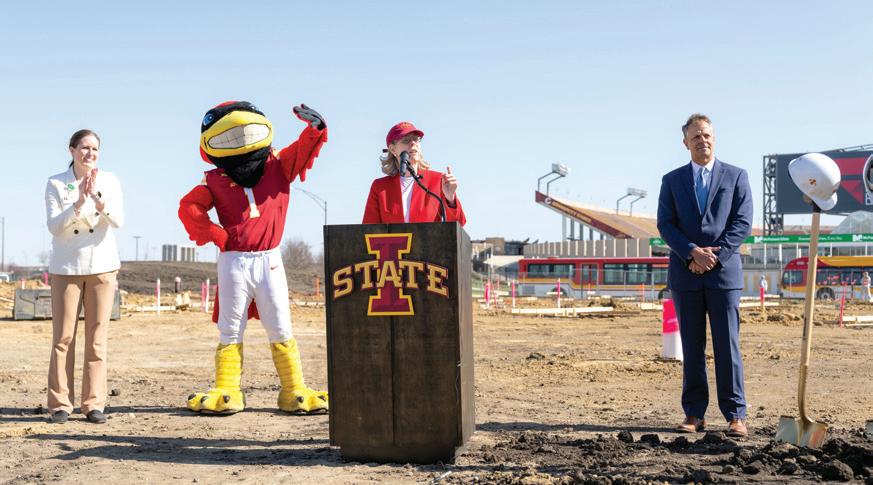
ALL-AMERICA HONORS FOR ISU STARS
IOWA STATE WOMEN’S BASKETBALL’S Audi Crooks was named a third-team All-American by the Associated Press (AP) and the U.S. Basketball Writers Association (USBWA). It marks the second and third All-America honors for Crooks in her career. The Cyclone center is the first Iowa State sophomore to earn a spot on an All-America team for both the USBWA and AP. Men’s basketball’s Curtis Jones, the Big 12 Sixth Man of the Year and All-Big 12 First Team selection, was named to AP’s Honorable Mention All-America team for the first time in his career.

Groundbreaking Moment
THIS PAST SPRING, ISU leaders and key community partners broke ground on the McFarland Clinic in the CyTown development. “The CyTown project would not be possible without the tremendous collaboration from many partners, including the Board of Regents, the City of Ames, and McFarland Clinic,” ISU President Wendy Wintersteen says. “We look forward to the ongoing partnerships as the CyTown development begins to take shape.”

SETTING THE PACE
TYRESE HALIBURTON HAS LED THE INDIANA PACERS to the NBA Finals for the first time in 25 years. Seeded fourth, the Pacers earned victories over the Milwaukee Bucks, the top-seeded Cleveland Cavaliers, and the New York Knicks in the playoffs. He made history in Game 4 of the Eastern Conference Finals against the Knicks, as he finished with 32 points, 15 assists, and 12 rebounds in the victory. He was the first player in NBA Playoff history to tally those numbers without turning the ball over. Haliburton is the fourth Cyclone to be on a team that has advanced to the NBA Finals.
ISU’s Program Leaders Ink Extensions
JAMIE POLLARD, THE LONGEST-TENURED DIRECTOR OF ATHLETICS in Iowa State history, received a five-year contract extension through June 30, 2030. “During Jamie’s 20 years, the university has celebrated all-time program bests academically and athletically, and significant growth in attendance,” ISU President Wendy Wintersteen says. “He has built a culture of success at Iowa State while navigating the many changes in collegiate athletics.”
Along with Pollard’s extension, Iowa State head men’s basketball coach T.J. Otzelberger agreed to a new contract that runs through June 30, 2032, and the winningest head coach in Iowa State football’s history, Matt Campbell, agreed to a new eightyear contract that will keep him on the Cyclone sideline through December 31, 2032.
Jenni Talbott, Cy, ISU President Wendy Wintersteen, and Andrew Perry
Audi Crooks
Tyrese Haliburton

COMPETITOR
Leading By Example
CYCLONE JUNIOR ROCCO BECHT IS MAKING AN IMPACT AMID NEW ERA OF COLLEGE ATHLETICS BY CALEB GRIZZLE
WHEN ROCCO BECHT TOOK TO THE FIELD IN FALL 2023, the starting quarterback was faced with the challenge, or opportunity, to bring stability to a program facing adversity.
He made the most of the starting spot, quickly setting freshman school records in completions, passing yards, and touchdowns, and winning the Big 12 Offensive Freshman of the Year award. More significantly, Becht earned the trust of his coaches, teammates, and fans with his stellar debut.
Goal to Give
Off the field, Becht saw an opportunity to take earnings he received from the new name, image and likeness (NIL) era of college sports and use them to make a difference in his local community.
Last year, Becht approached the We Will Collective with an idea to offer a free football camp at Perry High School, a school that was the site of tragic gun violence in January 2024. Becht covered all the expenses himself, recruited teammates to join him and 100 kids at the camp, and donated $7,500 to the football program.
This spring, Becht continued his efforts to give back, donating gaming consoles and games to every pediatric room at Mary Greeley Medical Center. Becht delivered the Xboxes himself, and stayed to play with patients.
“I think becoming a Division I quarterback during the NIL era is the best thing that’s happened to me,” Becht says. “I think more people should use their earnings like this and give it back to the communities, the people who need it. ... I want to see that happen throughout the country. We’ve seen a little bit of it, so hopefully it can grow.”
Championship Chase
Coming off a season in which he helped lead the program to double-digit wins for the first time in school history, Becht has his sights set on adding more to the record books.
“Our goal is obviously a Big 12 Championship,” Becht says. “We haven’t won a conference championship here in 133 years. That weighs a lot on our chest, but we love it. We want to be there. That’s where we expect to be.”
Iowa State and Becht’s journey to a championship game takes flight with a showdown against Big 12 rival Kansas State in the 2025 Aer Lingus College Football Classic in Dublin, Ireland, on August 23.
“It’s going to be a good chance for us to prove who we really are and really set the tone for what the season’s going to be,” Becht says. “I can’t wait for it.”

30 Years in Bloom
Reiman Gardens is celebrating 30 years of garden displays, public events, and educational programs at Iowa State University. Visitors can enjoy partythemed displays and a year of events, including a grand celebration on Sept. 13 that will feature an outdoor concert, food trucks, and more.
Image by Christopher Gannon
POSTCARD FROM CAMPUS
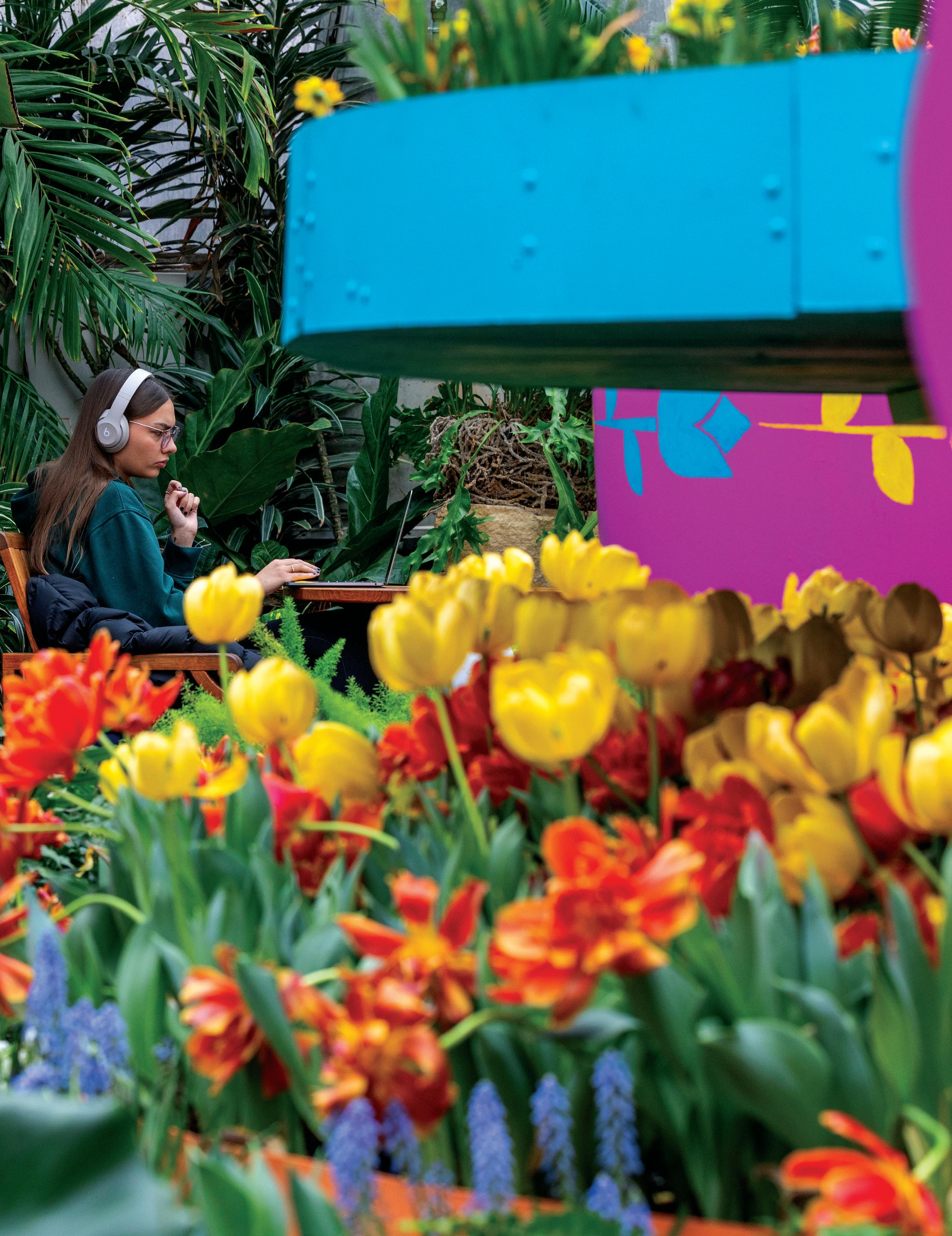
(THE STUDENT) RUN
WAY


STORY BY BRIANNE SANCHEZ IMAGES BY KATHRYN GAMBLE
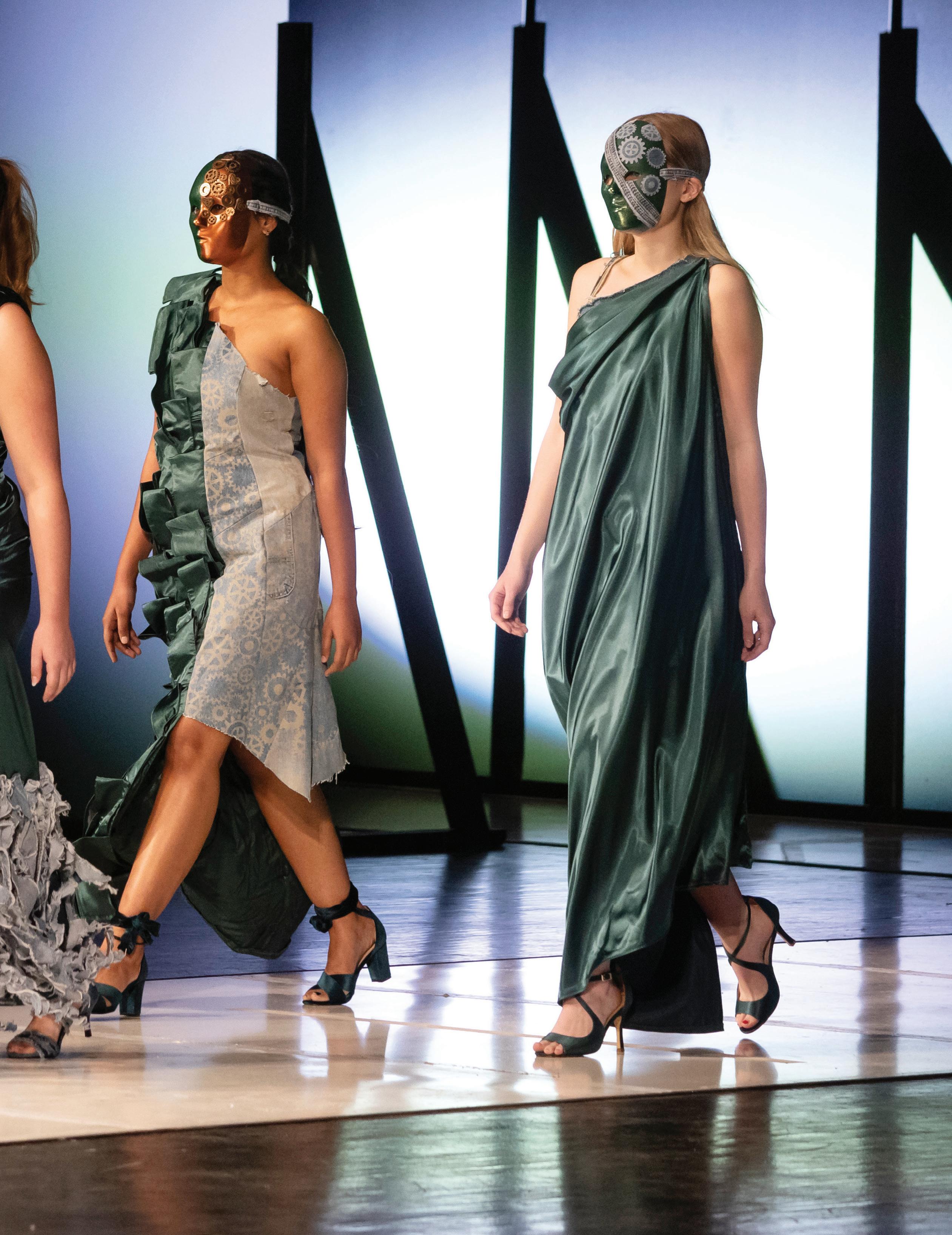

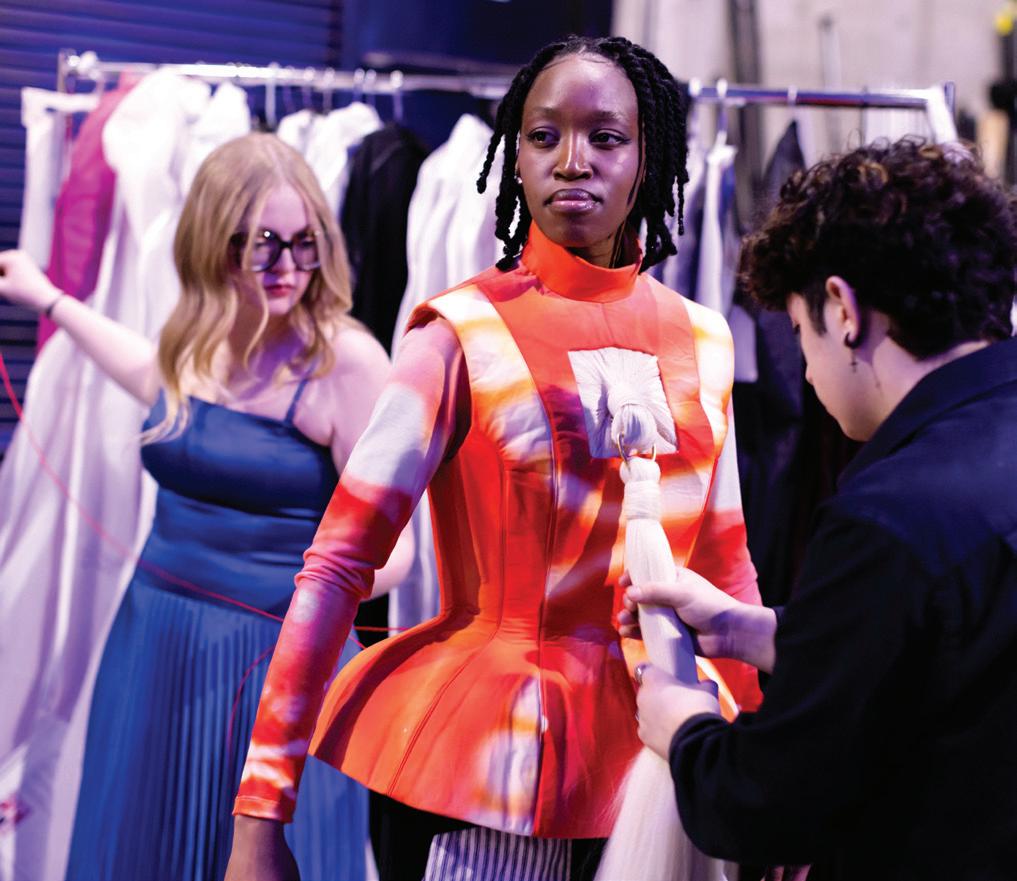
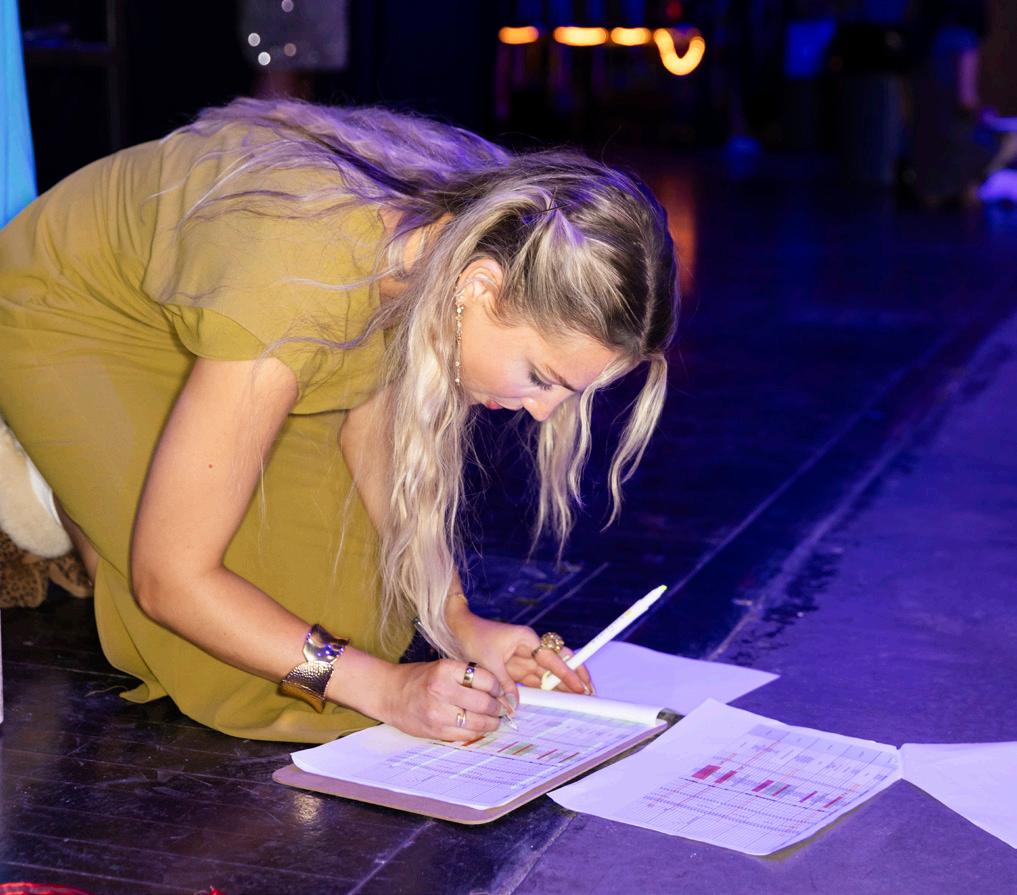
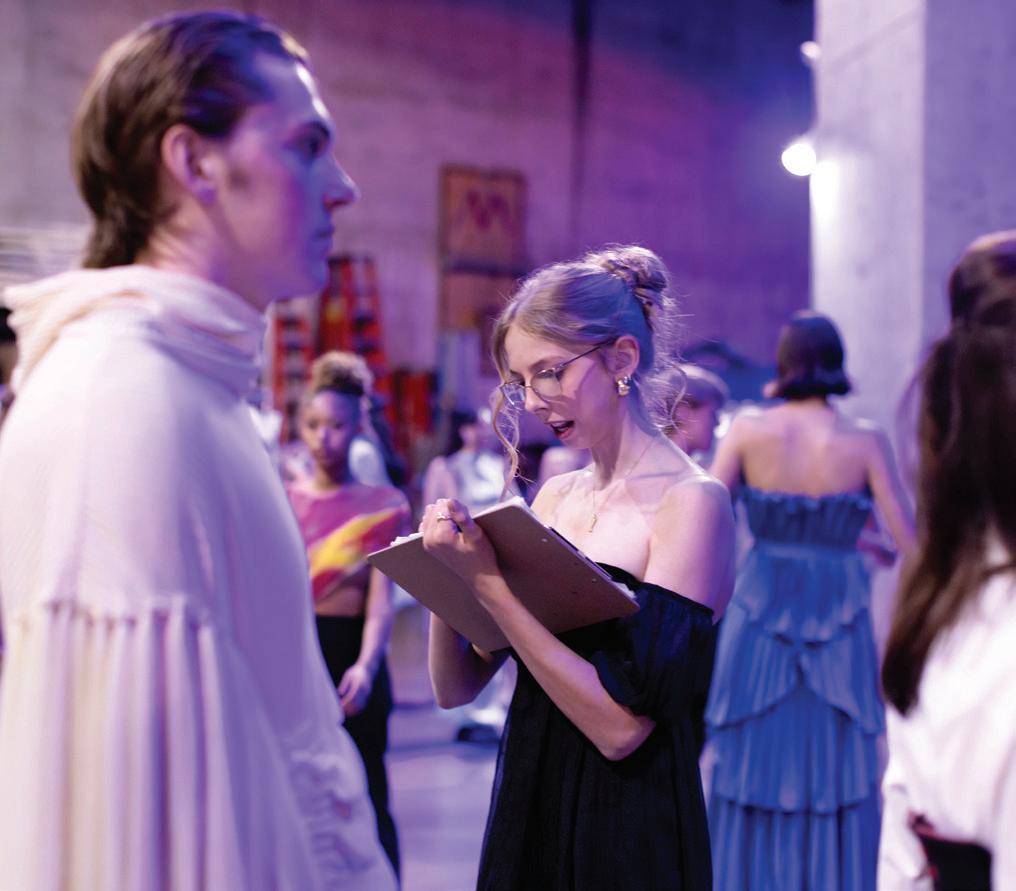
The Fashion Show, or “TFS,” begins long before the stage lights illuminate the first models on the runway. Before the thrum of electronica reverberates through the sold-out Stephens Auditorium crowd. Before the backstage hubbub of hair, makeup, and final fittings. Before accomplished guest judges fly in to score student designs. Before, even, the first stitch on any garment is sewn.
Nearly a year before its big night, TFS planning gets underway as aspiring student leaders interview for top production roles. Once chosen, four producers cast a collective vision. They coordinate across 15 committees and with more than 200 of their peers to stage a two-hour creative spectacle.
“It’s an exclamation mark experience,” says teaching professor Sarah Bennett-George (’06, ’11), who has served as TFS faculty advisor for 13 of its 43-years. “[The students involved] get to put together everything they’ve learned and, after all the late nights and sweat and tears, give people a glimpse of what they love and have worked hard at.”
Whether directing, designing, marketing, or modeling, contributing to such a large-scale undertaking is much more than a moment for students to strut their stuff. Months of preparation include ambitious outreach and philanthropic initiatives alongside innovative designs. Now among the nation’s largest student-produced annual fashion shows, TFS develops the next generation of leaders who will reinvent the multibillion-dollar textile and clothing industry. Enthusiastic engagement from prospective students and alumni perpetuates the show’s success.
INSTILLING FASHION ASPIRATIONS
For this year’s co-producers, landing a leadership role with TFS fulfills a long-held goal. After missing out on opportunities to get involved during his freshman year, Owen Abrahamsen (’25) secured a front-row seat to the show. He remembers sitting in awe of the experience.
“Seeing how the producers carried themselves on stage, I knew this was something I wanted,” says the creative and technical design major from Brownsville, Vermont.
A visual merchandising internship and a summer job at a Coach store in upstate New York gave him experience and connections to industry leaders. His senior year, Abrahamsen rose to the role of co-outreach producer and contributed two runway collections. He also introduced his team to the show’s guest designer, Parade, a size-inclusive and sustainable intimates brand. He befriended Raquelle Puglisi, now Parade’s senior brand marketing manager, during his summer job at Coach.
“It was important to find a guest company that aligned with how we wanted the fashion show to feel, look, and be perceived,” Abrahamsen says. “Parade promotes both cultural inclusivity and body positivity.”
Top: Committee members Olivia Fife and Roy Barron prepare Tumisang Leshoeli to model a design created by Kai Huntoon. Middle: Iowa State students, including design director Abigail Klauer (’25), spend months preparing for the event. Above: Benjamin Forman, left, wears a design by Kai Huntoon, while Katherine Fjellman (’25), right, checks on the lineup before models take the stage.


For many involved in TFS, their interest in the event starts pre-enrollment. Prospective students can attend “Behind the Scenes Day,” which gives them a first-hand look at all four degree focus areas: creative and technical design, merchandising and retail analytics, product development for apparel and soft goods, and fashion communications. The Fashion Show dress rehearsal caps off a day of campus tours, workshops, and panels. The experience inspired co-outreach producer Becca Parker (’25) to commit to Iowa State.
“I was choosing between 10 different colleges at that point,” says the recent alum from Libertyville, Illinois. “I decided to go on the (then virtual) ‘Behind the Scenes Day’ event and that’s how I heard about the show. I got involved in three different TFS committees over my time, and now we’re here.”
In her role as co-outreach producer, Parker helped spearhead this year’s record-breaking $44,422 FundISU campaign. Crowdfunding underwrites production expenses for future shows and contributes to several scholarships awarded to TFS participants.
FULL-CIRCLE MOMENTS
Weeks before the runway show, accomplished alumni assess garments as guest judges, scoring according to their expertise. They consider originality and creativity, construction and fit, and relevance to current market trends, among other criteria. Serving on this year’s review panel felt like a full-circle moment for Blaze Best (’19), associate designer at the menswear brand Todd Snyder.
“I know the weeks leading up to [TFS] are super stressful
Left: Garments from Parade, the show’s guest designer, are modeled by Marlo Belknap and Jack Leuer (’25). Right: Marielle Macdonald (’25) models a design by Max Veasman.
for everyone involved, but that’s how it feels when you do one in the industry,” Best says. “I love that pressure.”
His involvement with TFS led to a career-launching creative design internship with the menswear brand founded by Todd Snyder (’92). This year, Kai Huntoon (’25) earned that competitive opportunity; he received the Lora and Russ Talbot ISU Fashion Show Best in Show Scholarship for his avantgarde collections that captured judges’ attention.
Huntoon’s eye-catching ensembles opened and closed this year’s event, but it was his beautifully constructed handbag that first impressed Best.
“Off the gate, you could tell that there’s a high level of craftsmanship as well as storytelling in the great design details that he uses,” Best says. “Then there’s [Kai’s] distinct and unique taste and how he goes about his collections. He goes above and beyond.”
Huntoon, who grew up in central Iowa, sees a creative career in his future. He is also highly involved in “TREND,” a student-run magazine. Whether Huntoon follows in the footsteps of Best and Snyder or pivots to publishing, he’ll
be pursuing a passion.
“I’m a big dreamer,” Huntoon says. “I would love to have my own brand someday, or work at a top-tier fashion house. I’m also really interested in creative direction for a fashion or lifestyle magazine.”
Looking back, alumni in the audience recognize how participating in TFS shaped their Iowa State experience. It’s not just about career connections. For many, immersing themselves in the event leads to lifelong friendships.
“The Fashion Show is a special community,” says Sadie Besch (’24), who served as an outreach producer her senior year.
Now working in Boston as an allocation analyst in the TJ Maxx handbag department, Besch joined fellow TFS alumni at a pre-show reception. The recent fashion, design and merchandising program graduates at her table all landed roles in their areas of interest at big-name brands like Dior, in promotional apparel, and on the brand marketing team of the Kansas City Chiefs. Cheering current students on — this time as spectators — is the ultimate reunion.
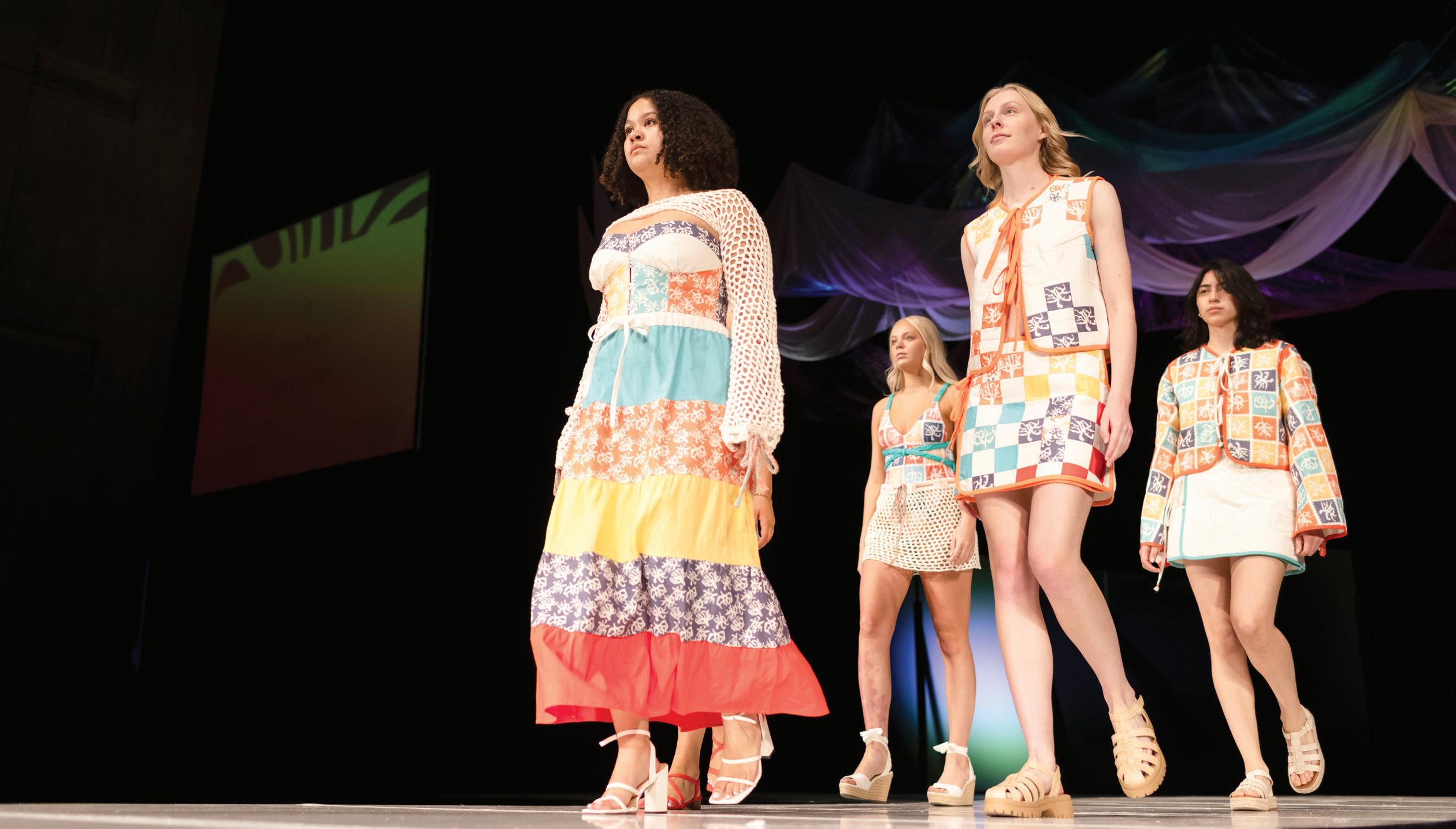
[The students involved] get to put together everything they’ve learned and, after all the late nights and sweat and tears, give people a glimpse of what they love and have worked hard at.”
Models Carrie Miliner, Addie Hunter (’25), Kate Nelson (’25), and Leslie Delgado (’25) display garments designed by Katie Bradley (’25).
A FASHION (R)EVOLUTION
In the weeks leading up to The Fashion Show, students can be found meticulously draping material on industrial design forms while the buzz of sewing machines and the occasional thud of a steel beam going into place fills the air. The large windows in MacKay Hall’s classrooms overlook the LeBaron Hall construction site, which will soon provide a state-of-the-art home for Iowa State’s fashion program.
While the MacKay sewing labs are temporary spaces, the program ensures students have access to the cutting-edge technology needed to power their future careers.
“The sewing labs have always been a home away from home for me,” Abrahamsen says. “I’ve always been impressed by how many resources we have available. New machines improve how we construct our garments, too. I used the industrial cover stitch machine a lot within the construction of my senior line.”
Student designers also use equipment in the Digital Apparel and Textiles Studio to incorporate digitally printed textiles and embroidery into their runway projects.
Though the trends have changed since The Fashion Show started as a simple showcase in MacKay Hall in 1982, Iowa State’s commitment to a hands-on education with a focus on textile science, innovation, and creativity that prepares students for careers in the global fashion industry remains steadfast.
The new LeBaron Hall is scheduled to open in fall 2026 with additional projects planned for the overall Health and Human Sciences Complex.




Alumni credit The Fashion Show with positively shaping their Iowa State experience through career connections and lifelong friendships. Above left: Victoria Silvar (’25) models a design by Kai Huntoon. Above right: Models walk the runway showcasing garments from all the show’s student designers. Right: Models display designs by Abigail Klauer.
Bypassing
Barriers

STORY BY ANDREW FAUGHT
IMAGES BY LAURA BARISONZI
Bypassing
Barriers
Alum Chad Bouton is a pioneer in the field of double neural bypasses who creates innovative technologies to help restore movement and independence in patients with paralysis
Chad Bouton was 26 and a graduate student when he was assaulted while out one evening with friends. The assailant threw Bouton to the ground, slamming his head into the concrete. The impact fractured his skull and left him with a pair of dangerous subdural hematomas.
“I was rushed to Des Moines, and the neurosurgeon had to do two lifesaving surgeries during the night,” Bouton (’93, ’96) says. “I’m extremely lucky.”
His recovery lasted several months, and it required speech and physical therapy. Bouton mostly lost his ability to speak, a condition known as expressive aphasia. He could, however, articulate two words: “Thank you.”
“I would say it over and over, and to this day, I think back on that,” he says. “I am thankful for ending up having a full recovery. Millions of people have these kinds of events — either a brain or spinal cord injury — and they’re not so lucky, having to live with paralysis or loss of sensation.”
Bouton couldn’t know it then, but the experience would lend uncommon empathy to what ultimately would become his life’s work: bringing movement and sensation to people who suffer paralysis due to traumatic brain injury, stroke, or disease.
After earning his degrees from Iowa State, Bouton worked as an engineer in the medical technology division at Battelle, where he began his research in the fledgling field of brain-computer interfaces, or BCI. Bouton had already studied
machine learning and control theory, a field of applied mathematics, to detect cancerous tissue in humans. BCI was the next big emerging innovation.
In 2004, his Battelle team was part of a historic moment: implanting the first long-term brain chip in individuals living with paralysis. At the time, their goal was modest but revolutionary — enable a person to control a cursor or a wheelchair with their mind. The chip, packed with nearly 100 electrodes, helped a paralyzed woman control her battery-powered wheelchair using only her thoughts.
“It was the first time we were cracking the neural code and learning the language of neurons,” Bouton says.
It would be in 2014, after years of technological and bureaucratic hurdles, that Bouton’s work helped a man move his hand using a single neural bypass — an electronic bridge that reroutes signals between the brain and the body around a damaged spinal cord. And less than a decade later, Bouton would achieve his next historic moment: restoring movement and the sense of touch to a man via the world’s first successful double neural bypass.
Bouton is a pioneer in the fields of bioelectronic medicine and neural bypass technology, where brain implants and wearable stimulation technology can help bypass damaged neural pathways in the human body. The high-tech bridge allows the brain to send signals to a computer, which then gives instructions to electrodes affixed to the skin, and then touch information is sent back to the brain. The instructions can stimulate movement and special electrical stimulation

patterns delivered to the brain help to restore sensation.
Even when the body is broken, the human brain, it turns out, still holds the power to connect.
“A person might not be able to speak or move, but they can still think about movement, and we’ve proven that the signals are there, and they’re often quite strong,” says Bouton, now vice president of advanced engineering at Northwell Health, director of the Neural Bypass and Brain-Computer Interface Laboratory, and professor in the Institute of Bioelectronic Medicine at Feinstein Institutes for Medical Research.
“You just have to have a way to tap into them.”
In 2023, Bouton, alongside bioelectronic medicine researchers, engineers, and surgeons, successfully tapped into those signals. During a 15-hour surgery, the team implanted five microchips into the brain of Keith Thomas. Armed with information from months of mapping his brain through functional MRIs, surgeons probed portions of the surface of Thomas’ brain, while Thomas provided real-time feedback of the sensations he was feeling in his hands. Through the artificial intelligence algorithms Bouton and his team developed, Thomas’ brain was re-linked to his body and spinal cord, restoring movement and touch.
Back in the lab, Thomas opened his hand and lightly closed it around his sister’s hand. “And he could feel it,” Bouton says. “There wasn’t a dry eye in the room.”
Thomas’ procedure marked the first time the brain, body, and spinal cord have been linked together electronically in a paralyzed human to restore lasting movement and sensation.
“When [he] thinks about moving his arm or hand, we
‘supercharge’ his spinal cord and stimulate his brain and muscles to help rebuild connections, provide sensory feedback, and promote recovery,” Bouton says. “This type of thought-driven therapy is a game-changer.”
Thomas, who was paralyzed from the chest down in 2020 following a diving accident, has been able to grasp, lift, and drink from a cup on his own, lift his arms fully, and feel his dog’s fur again. He says Bouton’s clinical trial gave him hope, and he was grateful to be a part of something so historic and much larger than himself.
“There was a time when I didn’t know if I was even going to live, or if I wanted to, frankly,” Thomas says. “And now, I can feel the touch of someone holding my hand. It’s overwhelming.”
To date, Bouton has secured 70 patents and worked to restore motion and sensation in multiple clinical study participants. His company, Neuvotion, a neurostimulation technology startup, recently gained FDA clearance for a wearable system that can aid recovery for people with limited hand function. Clearance is a step closer toward making the technology widely available.
Bouton is hopeful for the continued progress in the search for a cure for paralysis.
“Some people think we’ve crossed the 50-yard line,” Bouton says, noting that the number of BCI beneficiaries should swell in the next decade. “The FDA has written what’s called a guidance document for brain-computer interfaces. That’s always a telltale sign that they’re getting serious. It’s coming.”
Bouton, center, holds a 3D model skull and brain. Doctors and researchers used the 3D model to help identify where to place computer chips in a patient’s brain to help restore movement and touch.



Patient Keith Thomas had five small microchips implanted in his brain, forming a critical portion of the firstof-its-kind double neural bypass.


PROCEEDS GOING TO ISU ATHLETIC

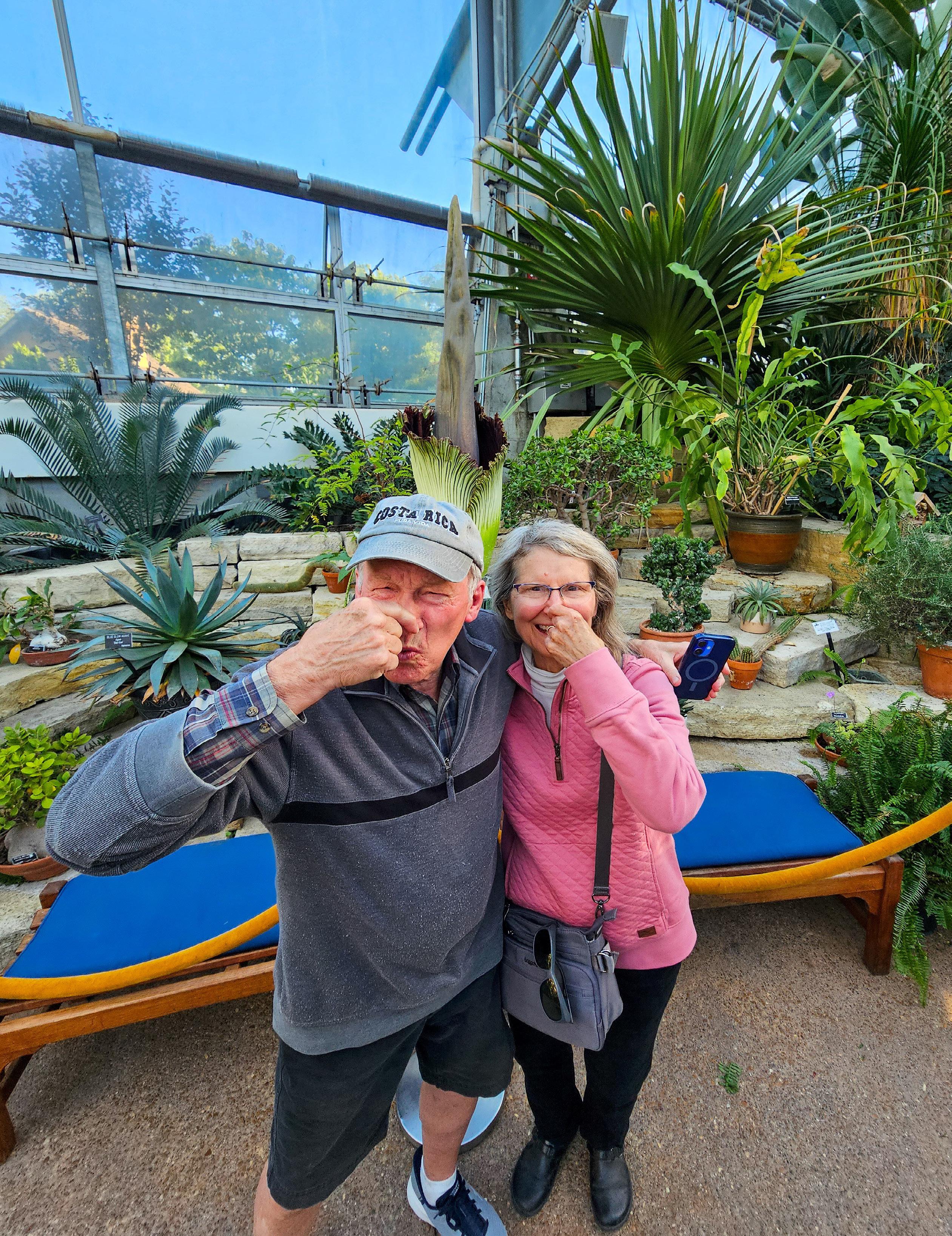
DARK SIDE OF THE BLOOM
Dan and Lana Gogerty (‘73) were two of approximately 12,000 people who visited Reiman Gardens in mid-May to experience Stink Floyd, Iowa State University’s corpse flower. On the full day of the flower’s bloom, the gardens had around 5,000 visitors, shattering an all-time single day attendance record.
Image by Andrew Gogerty
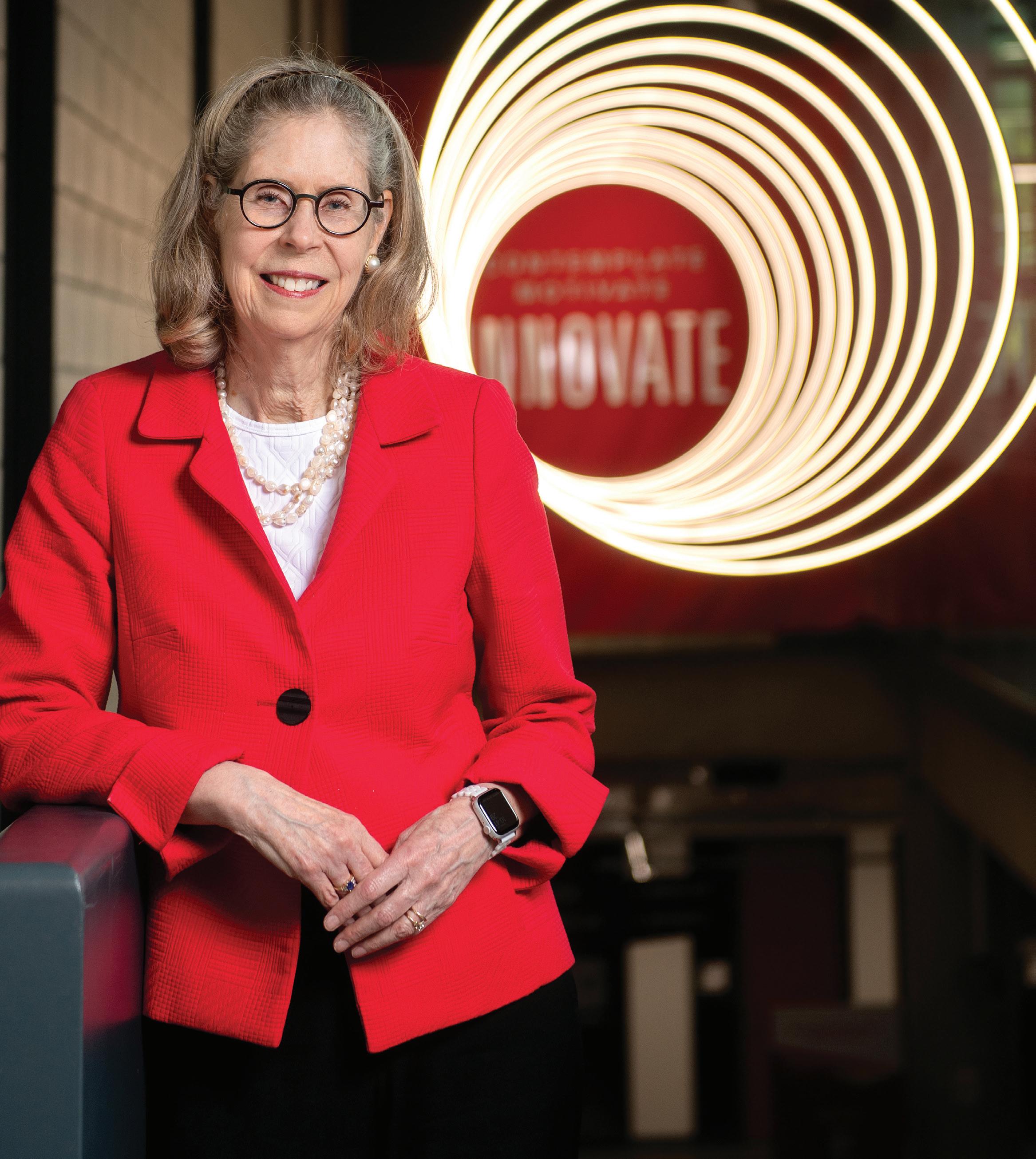
A Message for Iowa Staters
One of Iowa State University’s greatest strengths is our tremendously loyal and supportive alumni, friends, and stakeholders. As president, one of my joys is hearing your life stories and for me to tell you the latest stories of our campus life and mission.
It’s been a priority for me to work on strengthening the relationships the university has, and to forge new ones. The work requires me — and all of us at Iowa State — to tell our story in the most compelling, convincing, and consistent way possible.
That’s why I decided last summer to hire a consultant to conduct a comprehensive assessment of our communications and constituent engagement ecosystem — all the many ways that Iowa State University, the Iowa State University Alumni Association, and the Iowa State University Foundation connect with you and many others.
For years, Iowa State has used decentralized approaches for communication and engagement, especially to our alumni, supporters, and partners. Sometimes we’d hear from stakeholders who received multiple mailings and phone calls from one or more university units, all in the same week. Some felt confused about who to respond to, who did exactly what, and how to proceed.
When I was named president in 2017, I made a number of changes to build greater awareness of Iowa State’s hardearned, well-deserved reputation. I emphasized to our communications and marketing leaders that we needed to be viewed as “one university.”
We made important strides in the one-university approach. Among them is the alumni magazine you now hold in your hands. Iowa Stater was reimagined in 2022 with new direction and support from the university, alumni association, and foundation.
I decided to take a bigger step. The charge to the thirdparty consultant was to recommend a strategy and proposed organizational structure that would position us to be more strategic, cohesive, and consistent in our communications and engagement efforts.
Over five months, the consultant — The Segal Group — interviewed 270 people, reviewed more than 500 documents, and provided a peer university benchmarking.
In the consultant’s final report, one of the recommendations was to combine the ISU Alumni Association and the ISU Foundation, an action already taken by many of our peers and other universities. I named a review committee to take up this recommendation and provide me with a decision on whether we should move forward. In April, the review committee informed me that the committee had affirmed the recommendation.
Subsequently, an implementation plan was developed, led by Kurt Tjaden (’85), the acting Lora and Russ Talbot Endowed President and CEO of the ISU Alumni Association from March 1 to May 31, and Larissa Holtmyer Jones (’03, ’94), president and CEO of the ISU Foundation. They sought input from their board leaders, staff from both organizations, and Jeff Johnson (’14), the Lora and Russ Talbot
Endowed President and CEO who this past spring went on medical leave.
The plan they developed outlined three guiding principles:
Ensure the plan supports the mission of Iowa State University and advances the university’s commitment to excellence.
Ensure the plan supports an optimal approach for engagement and service to constituents that best serves the university and its long-term priorities and needs.
Ensure the plan recognizes that organizations work because of the people who work for them — the valued contributions each person can make. Dignity, respect, and fairness for everyone involved should be foremost.
A steering committee with members from both boards and the university was formed and is guiding the process. The committee sets direction and expectations for work teams focused on people, finances and facilities, communications, constituent engagement and programming, and governance.
The process for the combination began in earnest in May, with a goal of the work teams to complete the majority of their tasks by the end of September.
It’s a significant undertaking. But it’s one firmly grounded in both organizations’ collective strengths and proud histories.
I want to thank Chad Harris, chair of the ISU Alumni Association board of directors, and Mary Jane Hagenson, chair of the ISU Foundation board of directors, for their commitment in moving us forward toward a successful conclusion.
I am thankful for the leadership of Kurt Tjaden and Larissa Holtmyer Jones. I am especially grateful for Jeff Johnson, who has faithfully served the university, alumni association, its members, and all other alumni, students, and friends for more than 25 years. Jeff’s dedication and how he has proudly embodied the spirit of and service to “Cyclones Everywhere” is extraordinary. Thank you, Jeff.
Finally, I want to thank you, our tremendously loyal and supportive alumni, friends, and supporters. We will continue to communicate with you on progress and what you can expect in the future from this important initiative. It truly is exciting to consider new opportunities and to imagine how a more unified approach will benefit you.
WENDY WINTERSTEEN, PHD ‘88 IOWA STATE UNIVERSITY PRESIDENT


Innovating at Scale For Social Good
These days, you can often find one of three people at the helm of most major innovations: the restless engineer, the serial entrepreneur, or the unyielding idealist. Lalitesh Katragadda happens to embody all three.
Born in Andhra Pradesh, India, Katragadda (’91) began his educational journey at the Indian Institute of Technology Bombay, where he studied aeronautical engineering. He came to the U.S. to earn his MS in aerospace engineering and engineering mechanics at Iowa State University — a place he still holds dear.
Beyond being Katragadda’s “landing
point in the U.S.,” ISU also introduced him to his mentor, the late engineering researcher and faculty member, Bion Pierson (’61, ’63), who was a renowned expert in optimal controls. When Katragadda proposed using the emerging concept of genetic algorithms to solve a research challenge, Pierson encouraged the idea, rather than resisting.
“That openness is something I absorbed,” Katragadda says. “I carry that to today and beyond — beyond my love for complex systems.”
Though trained in aerospace, Katragadda made his mark in software. He co-founded Google India in 2004 and went on to design Map Maker, a
tool that enabled 4 billion users across 187 countries to contribute local knowledge to digital maps.
Katragadda says Google’s leadership team gave him one objective: create new products that are inspired by India but useful for the whole world. Prior to 2005, only 15% of the world was mapped to a geo-coordinate level. While this shortcoming quickly became apparent to Katragadda, it wasn’t until cyclone Nargis devastated Myanmar in 2008 that the wider public understood the need for accurate maps.
Though Map Maker had yet to officially launch, the United Nations requested its assistance. Within days, a volunteer team mapped 120,000 kilometers of roads and 3,000 hospitals and relief points — ensuring the delivery of disaster aid for thousands.
“By the time I left Google, they had used it in more than 300 disasters around the world,” Katragadda says.
Katragadda’s latest venture is Indihood, which seeks to provide Indian communities with the resources they need to improve their livelihoods. The first step was Avanti, a financial platform designed with new borrowers in mind. Now, Indihood is working on an agricultural platform that empowers farmers to manage their own supply chains. More robust business banking and healthcare provider platforms are on the horizon, as well.
Katragadda’s ventures are based in his belief that the majority of people mean well and strive to do good, and his faith that those he uplifts will pay it forward. With that mindset, he’ll continue to innovate and create tools and platforms that benefit those around him.
“Our job is not done until we build a successful technology-based world,” he says. “I think there is a valid definition of successful technology where the technology is only successful if all 8 billion people on the planet can use it and afford it.”
CYCLONE STORIES: LALITESH KATRAGADDA (’91) / BENGALURU, KARNATAKA, INDIA
— NOAH KIM
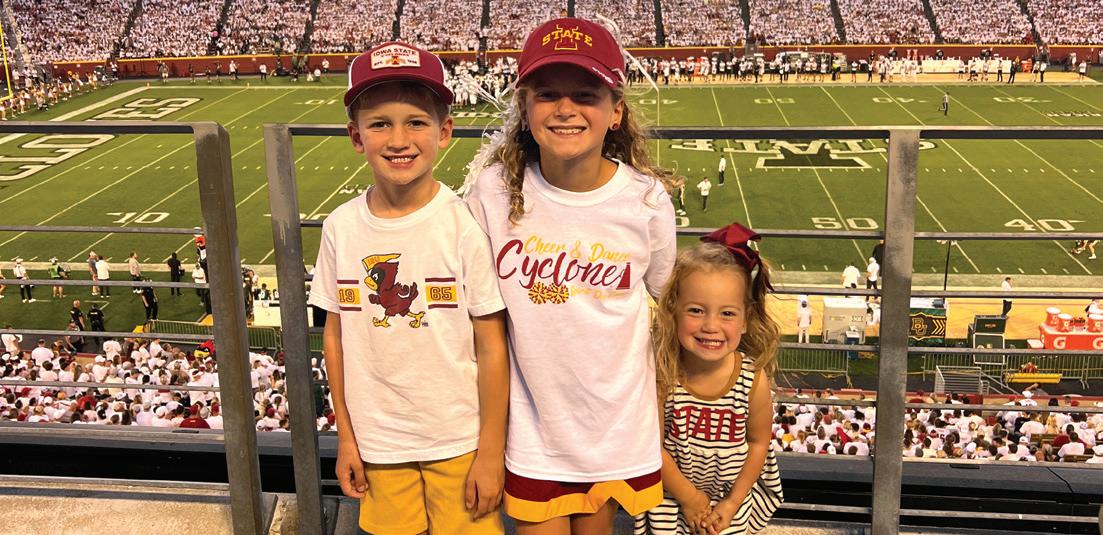


Future Cyclones

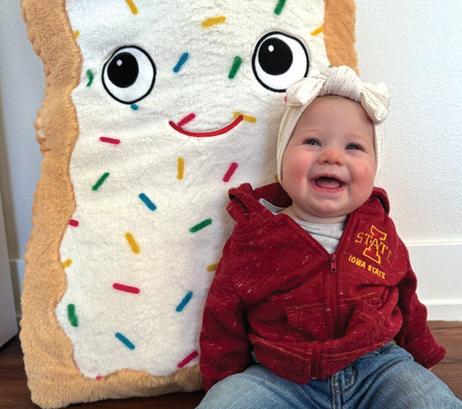
Theo, Ava, and Ellie: Submitted by Chris (’12) and Danelle (’11) Severn
2. Kathrynn and Mia: Submitted by Bryan (’08) and Nicole Schmidt (’09, ’13)
3. Emmy: Submitted by Christian (’13) and Kaitlyn Olson
4. Kinsey and Kelsey: Submitted by Jill Kerr (’07)
5. Annie: Submitted by Corey Munson (’94), and Taylor (’15) and Austin (’15) Lelonek
These young Iowa Staters are showing off their love for all things ISU! Visit isualum.org/Legacy for more information on how you can connect Cyclones of all ages with age-appropriate Iowa State gifts and programming year-round.
To submit a photo of your future Cyclone, email iowastater@iastate.edu or tag @ISUAlum on Facebook or X.
IF YOU’RE HEADED TO ...
Seattle
ISUAA SEATTLE CLUB LEADERS JODIE (’86) AND DARREN JENS (’86) HIGHLIGHT THEIR FAVORITE PLACES TO EAT, EXPLORE, AND ENJOY NEW ADVENTURES.

Dine at the many delicious restaurants in the area. Ivar’s is a long-standing favorite for fish and chips, with several locations around the area. Head to the Seattle Waterfront or Lake Union to indulge in a variety of fine dining restaurants.
Explore nature with the countless hiking options in county, state, and national parks. For those heading outside of the city, consider a visit to the ever-popular Snoqualmie Falls or San Juan Islands. A public art installation hunt for the five giant wooden trolls will take you across the Seattle area.
Spend a morning exploring Pike Place Market, where you can find fresh sea food, produce, flowers, and arts and crafts. There, you can also experience some of the best and most diverse local, family-owned eateries. After, stroll down to the new park that connects the market to the Seattle Waterfront, then consider a boat tour of the Puget Sound, take in views of the Olympic Mountains, take a ride on the Ferris wheel, see the sights at the aquarium or enjoy great local shopping.
1.
1.
4.
2.
3.
5.
IA ST8R PLATES
Head to iowastater.iastate.edu to read more Chime In stories.
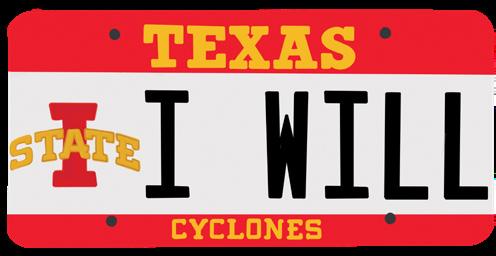
“As someone deeply inspired by Jack Trice’s story, its significance to ISU, and how it is woven into Cyclone Athletics, I decided to incorporate it into my life and display it with pride. I’m frequently asked about my plate’s meaning, which gives me the opportunity to share the legacy of Jack Trice wherever I go!”
TIM RAMIREZ (’90)

“There are too many Ohio State transfers down here in South Carolina, so I had to show my allegiance to Iowa State. I still get called a ‘Buckeye’ because southerners don’t know the difference between Iowa and Ohio!”
SALLY (SARA) GARVER (’81)

“We swapped out the ‘Si’ from our name and used ‘Cy’ instead to read ‘Cymon!’ We live in Florida now and framed our license plate from ISU. Our plates in Florida also have this vanity plate.”
RENEE (’85) AND TOM SIMON (’85)

“My wife, Mary Ann Rasmussen Simpson (’78), and I worked for Iowa State University from 1978 to 1995 in the Department of Residence. When I accepted the position as Associate Director of the University of Missouri Campus Dining Services, I decided to get a Mizzou vanity license plate that would communicate to the local Tigers my true loyalties.”
STEVE SIMPSON (’85)
“As an active alumni association volunteer during college and, since graduating, a life member, traveling cyclone, fan of all sports, it is only natural to have an ISU license plate! I live in Cocoa Beach and we have the luxury of using a golf cart throughout the city. What makes mine super cool is that it is on a cardinal and gold surf plate on a cardinal golf cart! We have a large blowup Cy that we put in the cart too.”
ANGELA ESSING
(’94)

Can you decipher these plates?


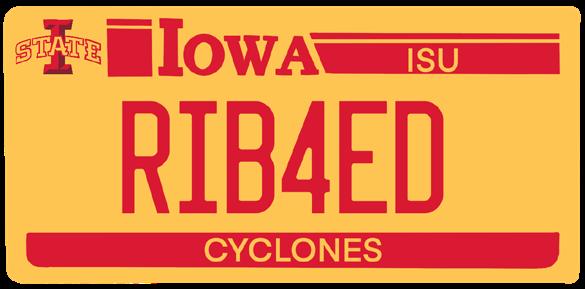



ANSWERS:
B31415R: “Using the numerical representation of pi (3.1415) the plate is the phonetic representation of the names Ben Payer (’21) and Bob Payer (’66, ’71). B = Ben and Bob, Payer = “Pie” R = 3.1415R = 31415R. As they are both engineers and love representing Iowa State, it is doubly appropriate.” — CHRIS PAYER (’90)
TLG8WIN: “We’ve always said that we tailgate victoriously — that we’ve already won the tailgate before the football game ever kicks off. So, our tailgate trailer has Iowa State plates with TLG8WIN (Tailgate Win) and our pickup has WINTLG8 (Win the Tailgate).”
— RYAN SCHON (’95)
RIB4ED: “My last name is RIED. The plate refers to the old adage ‘I before E except after C.’ Not one person over about 10 years could figure it out!” — JODIE LANGENBACH
4 GEN: “One of our Cyclone vanity plates (we have 3) is 4 GEN.
This represents the four generations of graduates, starting with my grandfather, Adolph Hoppe (1920); my mother, Kathryn Hoppe Huffman Hinrichsen (‘45); myself, Marcia Huffman, and my husband, David Stoever (‘81); and our daughter, Anne Stoever Garcia (‘04), and her husband, Michael Garcia (‘04, ‘11). We will eventually need to upgrade to 5 GEN as our grandson, Joshua Stoever, is a Cyclone freshman.” — MARCIA STOEVER (’75)
ANK FNTC: “We are huge Iowa State fans who live in Ankeny, but I am also the publisher of Ankeny Fanatic, a sister website to Cyclone Fanatic that primarily covers high school sports but also provides some ISU coverage.” — DAN HOLM (’88)
747PAML: “My wife and I ‘splurged for Cy’ when getting a new vehicle near our 40th anniversary. We lived in Pammel Court along with four other high school classmates (from a high school class of 55 graduates). Great times, reasonably priced.” — STAN ULLERICH (’84)
Farm, Fair, and Fame
STORY BY KATE TINDALL
Legendary baker Eileen Gannon (’86, ’91) feels a special connection to the Iowa State Fair.
“It’s the spirit of fairs that I love,” says the Mingo native. “When you live in a rural area, there isn’t a lot of entertainment. So, it was really special for a rural kid to go to the fair.”
Being from a farm, Gannon gravitated toward showing her family’s cattle instead of cakes and pies. But her interest in baking was always simmering and she first entered her baking at the fair when she was 12.
“The kitchen was a place where I could be productive,” recalls Gannon, the youngest of 14 children. “I loved being near my mother, Helen, and she was always in the kitchen.”
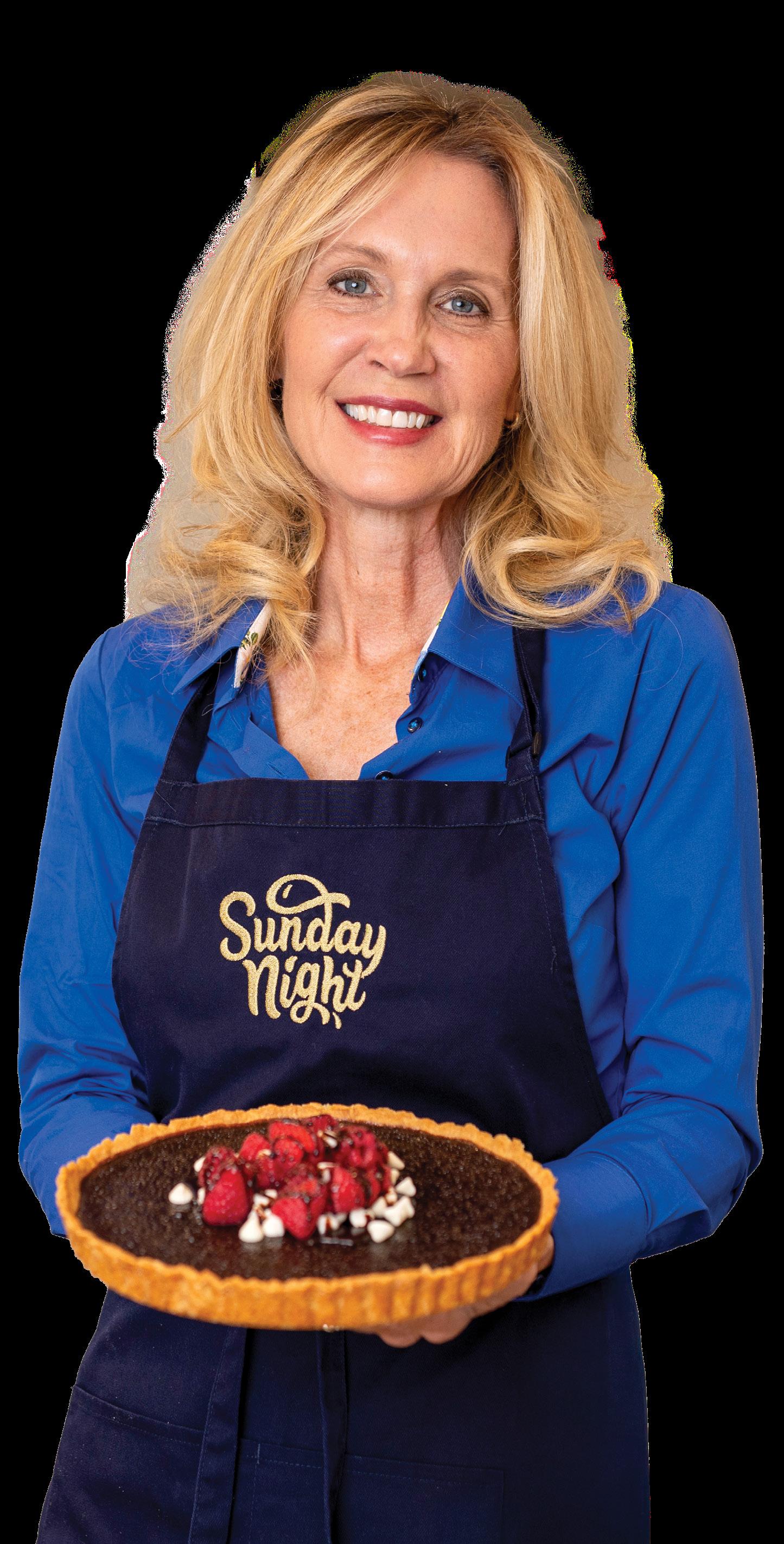



After graduating from Iowa State, Gannon built a successful career in nonprofit communications and then corporate communications and finance. She also found her way back to baking at the state fair, racking up 600+ ribbons at a fantastic rate. In 2021, she launched her own business, Sunday Night Foods, using recipes she had honed for decades. Four years later, Sunday Night is an award-winning company with premium dessert sauces in more than 3,000 stores.
Eyes On The Pies
“If you’ve ever won a blue ribbon at a state fair, we want to talk to you.”
It was a casting call for Netflix’s “Blue Ribbon Baking Championship,” a competition to air in 2024 with a cash prize and bragging rights any blue-ribbon winner would covet. Gannon had competitively baked on TV before, but this new experience would be truly grueling. Four weeks baking in kitchens she didn’t know under a tight timeline.
“You go in knowing that your vulnerabilities will be displayed on camera,” Gannon says. “If you cut yourself, if you break bowls, if you cry, it’s all out there.”
Gannon made it to the finale before placing third overall of 10 contestants, winning challenges throughout for historied recipes such as her Grandmother McGreevy’s 133-year-old blueberry pie.
“I was proud to represent the Iowa State Fair,” she says. “The best bakers I’ve ever competed against were at the Iowa State Fair.”
Sunday Night
Gannon has sworn off TV competitions for the present. She wants to focus on growing Sunday Night Foods, where she’s
launched a new line of caramel sauce and has ideas for more products. She also wants to savor moments with her family. Sunday nights are a sacred time, like the nights of her childhood spent with her mother, whose tradition of sundaes on Sunday nights inspired the company name.
As a professional baker, Gannon can no longer enter the Iowa State Fair, but that won’t stop her from enjoying it — just like any farm kid would.
“I grew up showing cattle at the fair, so I still see the fair through the lens of a competitor,” she says. “Many people, especially livestock competitors, have worked all summer to prepare their entries in the fair. I see their love and pride and sense of accomplishment that can’t be found anywhere else.”
A Slice of Advice
“Don’t rely on social media influencers, who probably don’t know any more than you do,” Gannon says. “For aspiring bakers, buy cookbooks written by pastry chefs.”
Gannon’s top three books:
• “Bouchon Bakery” by Thomas Keller
• “Bakewise” by Shirley Corriher
• “The Cake Bible” by Rose Levy Beranbaum
Left: Gannon takes her steer for a walk at the Jasper County Fair in 1979. Steers were sold at the end of the summer, which was the hardest part for Gannon, so she switched to showing heifers that would be returned to her family’s herd. Right: Gannon’s mother and father, John and Helen, are pictured enjoying Helen’s famous gingersnap cookies. Gannon made her mother’s gingersnap cookies for the finale of Netflix’s “Blue Ribbon Baking Championship,” with judge Sandra Lee praising them as the best gingersnap cookies she has ever had.
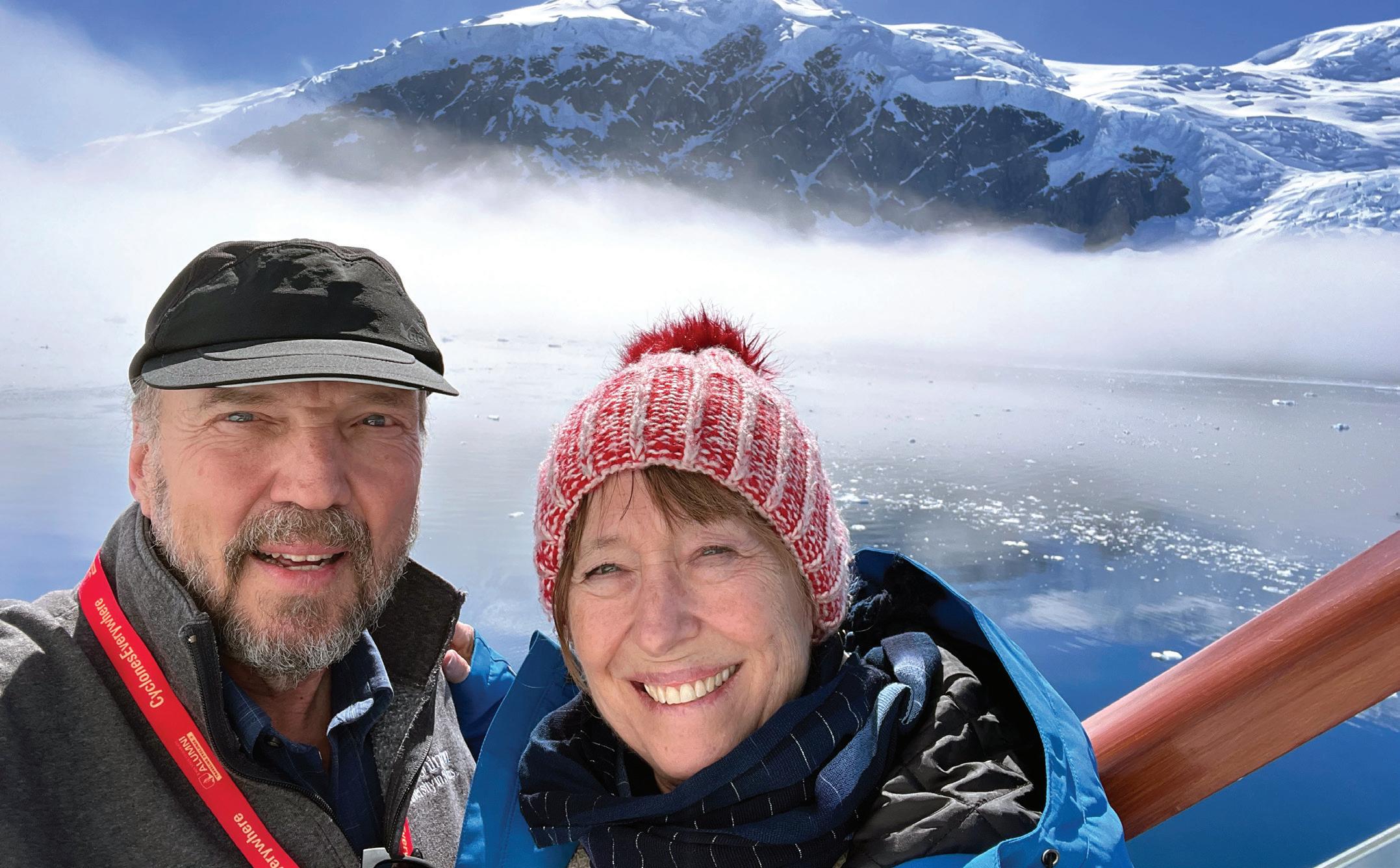
CYCLONE STORIES: CHERYL (’77) AND DON (’77) HEMANN / KIRKWOOD, MISSOURI
Planes, Trains, and Traveling Cyclones
Crawling through the Great Pyramid. Snorkeling in the Great Barrier reef. Polar plunging in Antarctica. These are just a few of the “pinch me” moments Don and Cheryl Hemann have experienced over the past year. During much of their marriage, the Hemanns only traveled domestically. Retirement kickstarted their commitment to international adventures, and between February 2024 and January 2025, they managed to visit all seven continents.
The goal wasn’t initially to visit all seven in a 12-month span. Canceled trips (Australia and New Zealand because of the pandemic) and Peru (because of political unrest) were rescheduled for 2024. And between those trips, the Hemanns were celebrating their 50th wedding anniversary and wanted to celebrate with two more trips — one with their family on a Disney cruise to Alaska. The second was a bit more of a unique experience — the Iconic Destinations by Private Jet trip through the ISU Alumni Association Traveling Cyclones program.
“We debated it because it is a little on the expensive side, but my rationale was, if you divide the money over 50 years, it’s very reasonable,” says Don (’77) with a laugh. “I even
broke it down to every week so that it would really become cheap. It was definitely worth the trip and was a perfect 50th wedding anniversary gift to each other. It was around that time when we realized we were on track to hit six continents that year. And I asked, ‘how do we get to the seventh?’”
The Traveling Cyclones program provided again, this time with a January 2025 trip to Antarctica.
“‘I’m a summer person,” says Cheryl (’77). “And I’m sorry, but Antarctica in summer is not warm, so I said, ‘You go ahead.’ Then I read more about the trip, had FOMO [fear of missing out] and decided I needed to go, too.”
During their year of travel, they visited Australia, New Zealand, England, Egypt, Jordan, India, Cambodia, Vietnam, Oman, Peru, Ecuador, the Galapagos Islands, Argentina, and Antarctica, all with fellow Traveling Cyclones.
“There’s a saying that I read a while back that says ‘you never travel alone,’” Don says. “With Iowa State, you truly never travel alone because you get on these trips, and you meet people and have a commonality right away. You immediately have something to connect to with people. We have made some good friends along the way.”
— KIRSTEN KRAKLIO
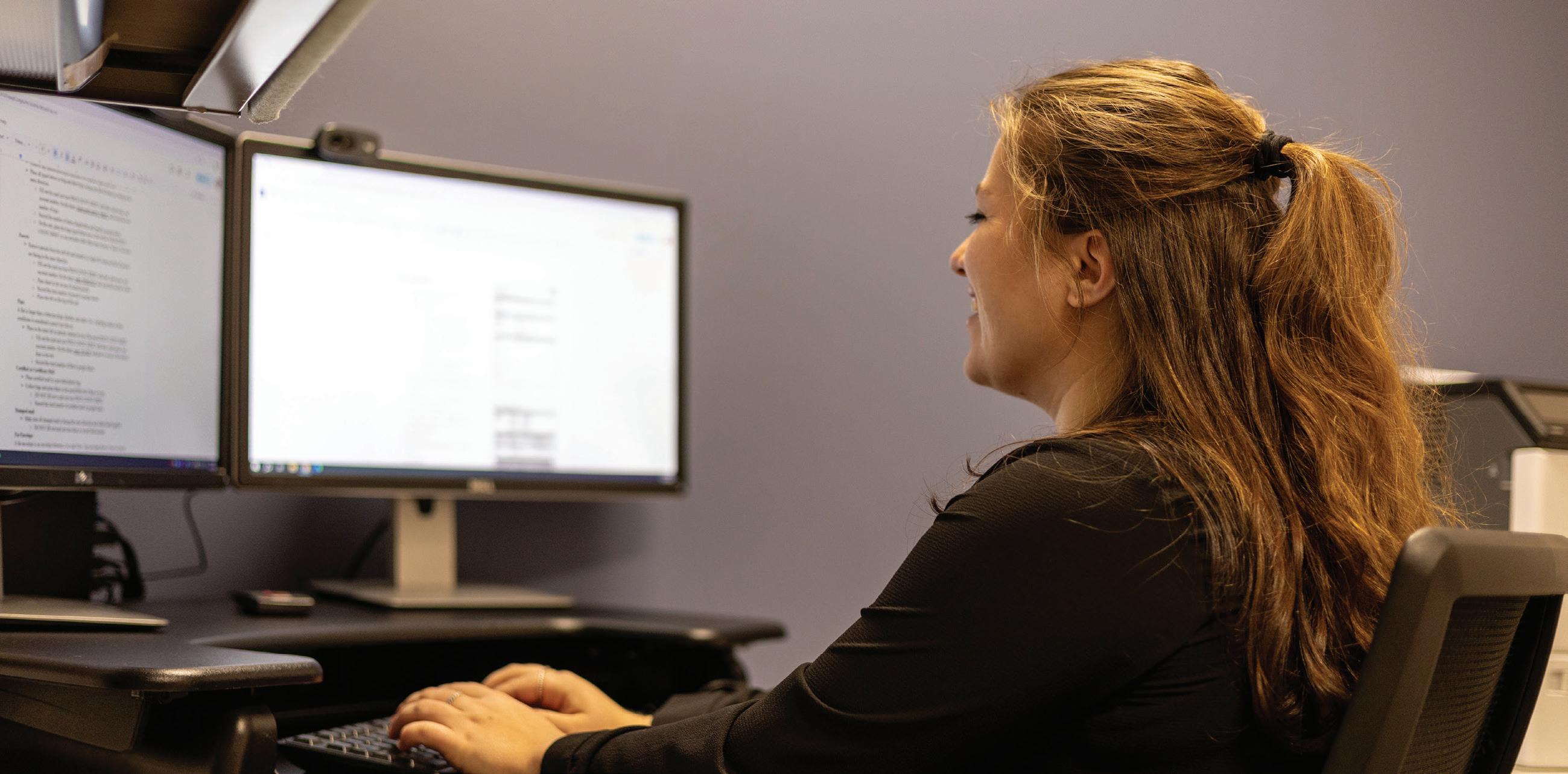
Master of Healthcare Analytics and Operations
#6 in the nation for best online master’s in healthcare analytics programs

An internship is a key component of this program. As an intern with McFarland Clinic in Ames, Iowa, Jennifer Standish learned about the business side of healthcare.
“It has been great to see how this internship applies directly to all my courses, especially in cases where I did case studies in class. It was amazing to do that and then see all those learnings and concepts in real-time, in real action here,” she said.
ivybusiness.iastate.edu busgrad@iastate.edu 515-294-8118
The Iowa State University Master of Healthcare Analytics and Operations (MHAO) degree is tailored to the needs of working professionals in the healthcare industry.
Affordable
Fully online No GMAT/GRE required Can be completed in as little as 15 months
Celebrating Cyclones Everywhere
Over 400 Cyclone alumni and friends played a key part in connecting the next generation of alumni with Iowa State during the 2025 Cardinal & Gold Gala at the Community Choice Credit Union Convention Center in Des Moines earlier this year. The event raised more than $85,000 for ISU Alumni Association programming and the New Graduate One Year Paid Gift Membership Program via a live and silent auction, games, raffles, and direct donations. Cardinal & Gold scholarship recipients, supported with endowed funds raised at past galas, were also honored.
2025 Cardinal & Gold Co-Hosts
Deborah (’81) and William (’81) Stearns
Kari and Todd (’94) Van Thomme
Stacie (’11) and John (’11) Hooker
Special Thanks
ISU President Wendy Wintersteen (’88) and Robert Waggoner
Brent Blum (’13) and Matt Van Winkle (’13), emcees
$10,000 Cardinal & Gold Legacy Benefactors
Cynthia Thorland (’84) and Fritz Weitz
$5,500 Forever True Benefactors
Sally (’71, ’77, ’99) and Kim Beisser
Brad and Lesa Lewis
Nyemaster Goode
Sigler Companies
Lora (’17H) and Russ (’17H) Talbot
$2,750 Bells of Iowa State Benefactors
Karen (’92) Heldt and Jay (’90, ’93) Chapman Bank of America
Dentons Davis Brown
Ryan (’03) and Sara Downing
Jon Fleming (’75)
Peggy and Jeff (’14) Johnson McFarland Clinic
Mary (’78) and Tim (’76) Wolf (Phantom Attendees)
$550 Cardinal & Gold Supporters
Cathy (’88) and Mark (’88) Schmidt
Kathy (’80) and W. Brent (’79) Taylor
Hallie Still-Caris (’83) and Dave Caris (’83)
Rebecca Miller (’06) and Timothy Beauchamp (’99)
Eric (’11) and Mackenzie Tubbs
Lori (’93) and Dwayne (’93) Vande Krol
Beverly (’60, ’70) and Warren (’61) Madden
Games and Cocktail Sponsors
Green Hills
Iowa Distilling Company
ISUAA 2025 Cardinal & Gold Scholarship Recipients
Alisa Deo, Kinesiology, Urbandale
Ana Fleming, Graphic Design, Wellman
Harlee Flynn, Accounting, Creston
Caisha Mohamed, Software Engineering, Des Moines
Kenaiya James, Criminal Justice, Ames
Autumn Rosol, Animal Science, Dumont
Craig and Terry Denny ISU Alumni
Association Cardinal & Gold College of Human Sciences Scholarship
Leah Becker, Kinesiology and Health, Jesup
Terry Marie Denny ISU Alumni
Association Cardinal & Gold College of Engineering Scholarship
Seth Benschoter, Engineering, Waverly
ISUAA Board of Directors Cardinal & Gold Leadership/Terry Denny Memorial Scholarship
Rylee Bezoni, Family & Consumer Sciences Education, Cherokee
Lora & Russ Talbot ISU Alumni
Association Cardinal & Gold College of Veterinary Medicine Scholarship
Matilyn Wheeler, third year Veterinary Medicine, Lorimor
Amber Vegter, fourth year Veterinary Medicine, Ames
Iowa State University Stadlman Family
Cardinal & Gold Scholarship
Emily Trumm, Animal Science, Cascade
J. Elaine Hieber Cardinal & Gold Scholarship
Kerrigan Irlbeck, Kinesiology and Health, Carroll
SAVE THE DATE for the next Cardinal & Gold Gala on Feb. 27, 2026.

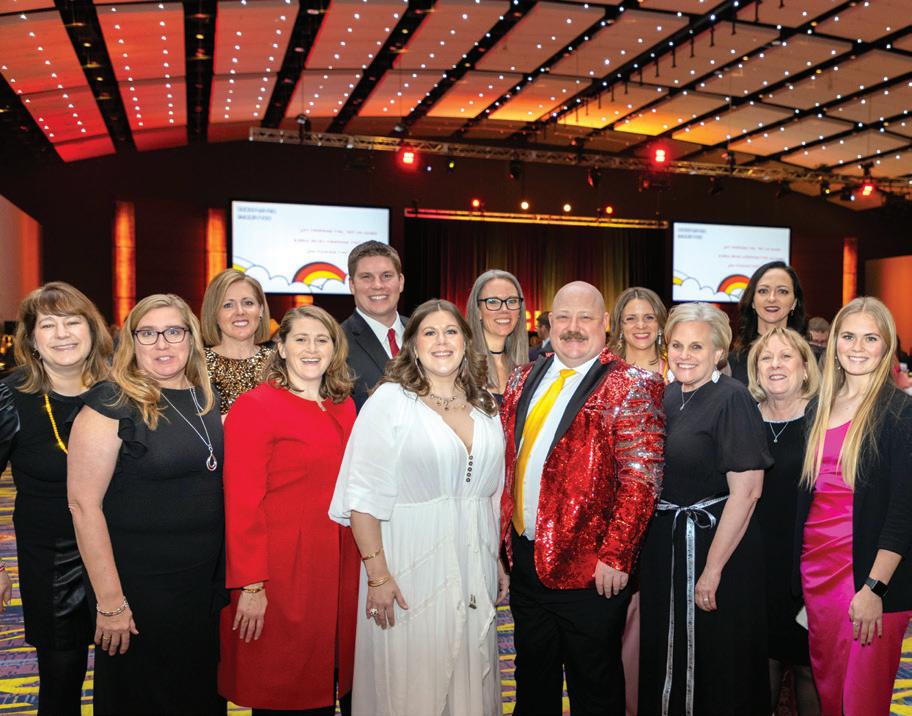



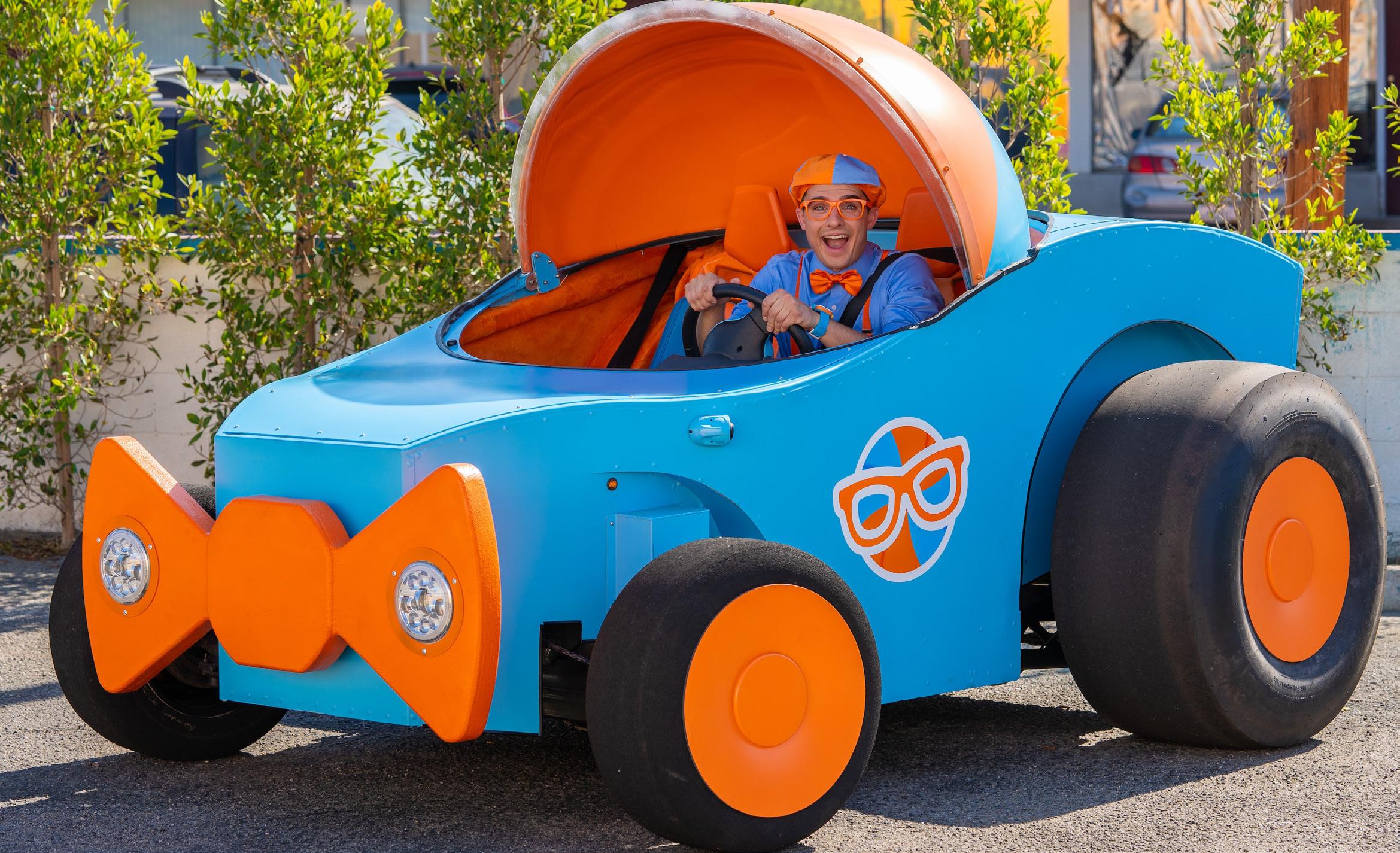
Becoming Blippi
An Iowa State alum has landed a role on one of the most popular live-action preschool shows. Ben Mayer can now be seen on “Blippi,” an innovative, digital-first content show that has more than 1 billion monthly views across streaming platforms.
At Iowa State, Mayer (’21) performed in several theater productions, but an inquisitive mind led him to study anthropology.
“A huge thing anthropology teaches you is that we are a small part of the world,” Mayer says. “It teaches you understanding and how to be captivated by things that are different than your experience.”
That curiosity paid off when a casting call came his way in early 2023 that seemed too good to be true. Shortly after auditioning, Mayer flew to Los Angeles for multiple test shoots and a “Blippi Boot Camp” to learn more about the role. “I spent two weeks diving into the character,” Mayer says. “I got vocal lessons, improv lessons, and movement coaching, which was so fun.”
Mayer made his debut in November 2023 in Blippi’s Vroom Vroom Vehicle Show, a new four-episode series in which Blippi teams up with Monster Jam, Caterpillar, and F1 to explore different types of vehicles.
“Blippi encourages a lifelong love of learning,” Mayer says. “Blippi is here to become your kid’s best friend and inspire them to learn through play with
the fun, engaging content and experiences he creates.”
On a recent trip to LA, Mayer visited a children’s hospital as Blippi.
“The episodes are so fun, but visiting Children’s Hospital Los Angeles was maybe the most meaningful thing I’ve done,” Mayer says. “I got to see reactions in person and see that joy come across these kids’ faces who have to go through some awful stuff.”
Growing up, Mayer often spent time in his mother’s classroom interacting with children while summers included working as a camp counselor.
“Everything in my life teed me up perfectly to get this role,” Mayer says. “To have that impact and that outreach is huge.”
— MATT VAN WINKLE
CYCLONE STORIES: BEN MAYER (’21) / AMES, IOWA
2025 FACULTY-STAFF INSPIRATION AWARDS
Six awardees were honored with Faculty-Staff Inspiration Awards on May 8, at the ISU Alumni Center. Honorees were selected based on nominator statements portraying their significant influence on their former students’ lives. The Faculty-Staff Inspiration Award Program is funded by the Nancy and Richard Degner ISU Alumni Association Endowment. Nancy (’72) and Rich (’72) are life members and sustaining donors to the ISU Alumni Association. Nominations are due Dec. 1 annually and can be submitted at www.ISUalum.org/Awards.

JAMES ALLEMAN Professor Emeritus
“He gave me every inspiration I needed to regain faith in my dream [of becoming an academic researcher] and start chasing it once again. ... He gave me a role model to look up to and a mentor to seek advice from who was always there for me and anyone in need.”
—
ALIREZA
SASSANI (’18)

BETH MARTIN
Teaching Professor of German
“Of my five semesters as an undergraduate student at ISU, I chose to spend four of them in her classroom, where the atmosphere she cultivated ... enabled me to make some of the most impactful relationships of my college career.”
— OLIVIA BUTT (’22)

LAUREN SCHALINSKE
Divisional Communications Lead, (’14)
“Lauren has shown me what it means to be a confident, caring, calm, and creative leader. Her example has shaped who I am today and inspired the kind of professional I hope to become. ... Lauren’s support, mentorship, and friendship have profoundly influenced my college experience, and my life is better because of her.”
— KYLIE EGBERT (‘25)

JEN HACKE SASS Event
Planner
“Jen is an ally, and has helped a lot of marginalized students when they are struggling both inside and outside of the classroom. She has created a community of love and warmth, a place where students feel safe to just hang out, or to chat with her.”
— CAMRYN MCPHERSON (’22, ’24)

CHERYLL REITMEIER
Professor Emeritus, (‘88)
“She has a rare gift for connecting with her students on a personal level, building bonds that extend well beyond graduation. ... To this day, I consider her one of my life mentors, someone I can turn to for guidance, wisdom, and support.”
— FRANSISKA ANDERSON (’01, ’03)

MITCHELL SQUIRE
Morrill Professor of Architecture, (’94, ’01)
“He demonstrates what is possible, and shows that an education at Iowa State opens thousands of doors: I have seen this with many of his other students who are leaders in their fields across the globe. The impact that Mitchell has had on our lives is tremendous.”
— NORA WENDL (’03, ’06)
2025 WALLACE E. BARRON ALL-UNIVERSITY SENIOR AWARD RECIPIENTS
The Wallace E. Barron All-University Senior Award recognizes outstanding seniors who display high character, outstanding achievement in academics, and university or community activities, and who show promise for continuing these qualities as alumni. The award is named for Wallace E. “Red” Barron (‘28) director of alumni affairs at Iowa State from 1937 to 1968.



HANNAH EVEN
Culinary Food Science Denver, Iowa
Hannah Even makes a positive impact on others and is known for her passion of food sciences, strong leadership skills, kind nature, and her dedication to giving back to the community.
“Hannah is a true representation of a Cyclone — driven, selfless, and committed to excellence in every aspect of her life,” writes Erica Beirman (‘95, ‘98), a teaching professor in the Department of Food Science and Human Nutrition. “... What truly defines Hannah is her persistent dedication to serving others. No challenge is too great for her to manage, as she balances demanding responsibilities with grace.”
CLAIRE FRANCISKATO
Diet and Exercise
Lee’s Summit, Missouri
Claire Franciskato exemplifies high character in every aspect of her life — whether in academics, leadership, or community — and has an ability to bring out the best in those around her.
“Whether she is leading a major university event, coordinating a philanthropy initiative, or supporting her peers through difficult circumstances, Claire’s thoughtful approach ensures that her actions align with her values and contribute meaningfully to the success of the community,” writes Shellie Anderson (‘88), VP Business Development and Constituent Engagement at the ISU Alumni Association.
JENNIFER HOLLIDAY
Agriculture Studies, Journalism and Mass Communications, and International Agriculture Greenfield, Iowa
Jennifer Holliday aims to serve her community and leave a positive impact in everything she does.
“Of all of these accolades for Jennifer, the simple one that says it all best, is that she is a wonderful person always ready to help others, to add her positive energy to every group and conversation, and to make the world around her a better place,” writes Daniel Robison, Dean of the College of Agriculture and Life Sciences.

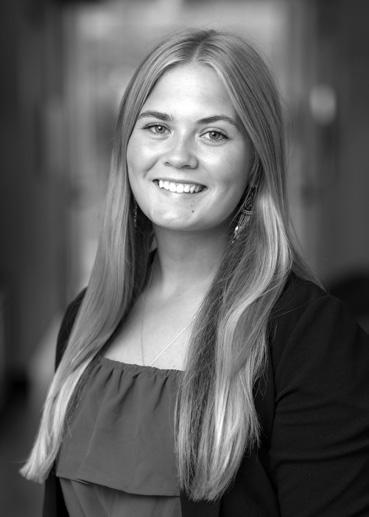
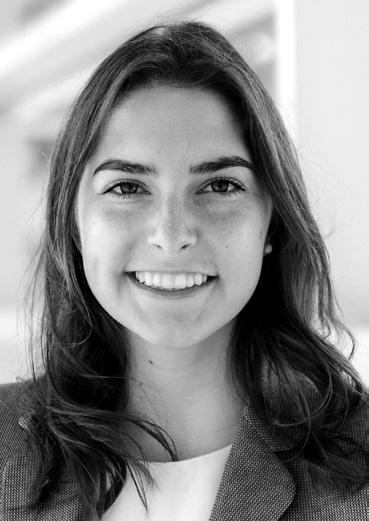

JONATHAN NEVENHOVEN
Accounting, Business Analytics
Waukee, Iowa
Jonathan Nevenhoven maintains high profile, high impact roles in a variety of organizations, standing out among his peers as an exceptional campus leader.
“In the 20-plus years I worked with students at Iowa State University, I cannot recall a student in the Ivy College of Business who has been more involved and at such an outstanding level,” writes Kathryn Wieland, former business career services director. “In addition, the style in which Jonathan displays leadership is warm, welcoming, and present.”
MACKENZY RUFF
Animal Science, Agricultural Studies
McGregor, Iowa
Mackenzy Ruff displays exceptional leadership at Iowa State, making a significant impact on both her peers and the university community.
“Mackenzy consistently demonstrates high character through her leadership, relationships, and approach to challenges,” writes Tom Elston (‘09, ‘23), former vice president of operations at the alumni association. “One of her standout qualities is her ability to balance multiple commitments while maintaining a strong sense of integrity and respect for others.”
MADELINE STADTMUELLER
Biochemistry
Ames, Iowa
Madeline Stadtmueller is dedicated to excelling personally, professionally, and academically as a Cyclone.
“Maddie has been instrumental in the Iowa State and Ames communities,” writes Donald Beitz, distinguished professor in the Animal Science and Biochemistry, Biophysics and Molecular Biology departments. “She has gone above and beyond to join clubs and activities that allow for community involvement, which speaks to her character and desire to give back to the community at Iowa State, in Ames, and in her hometown.”
ADAM WOLF
Construction Engineering
Ames, Iowa
Adam Wolf is highly engaged at Iowa State, actively promoting initiatives that build community and enhance student life.
“Adam’s courage, commitment to leadership, and outstanding campus involvement have left a lasting impact on the Iowa State community, his fraternity chapter, and everyone who knows him,” writes Dave Hansen (‘93), executive director and CEO of FarmHouse International Fraternity. “He truly stands out as a remarkable young man.”








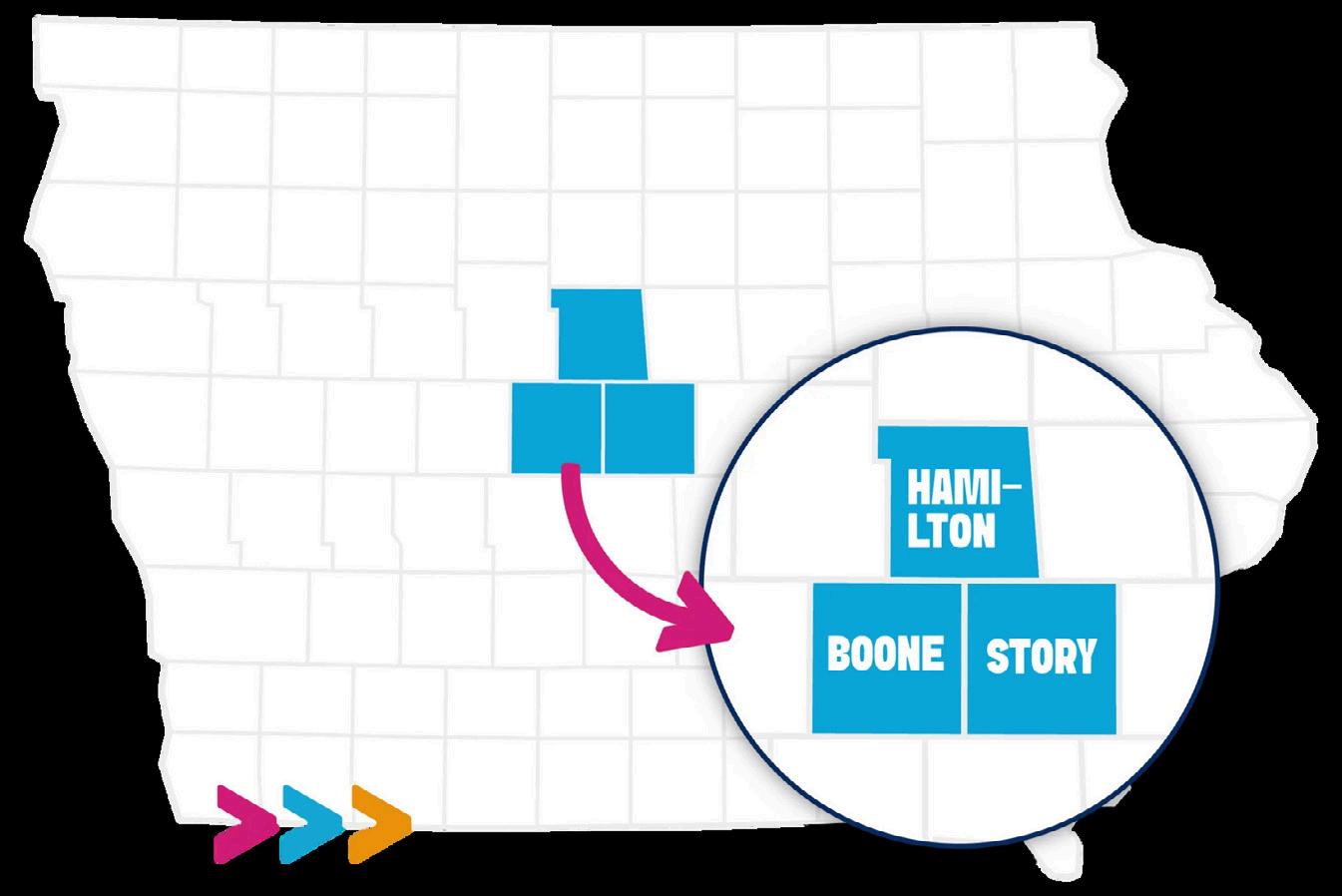











ISU ALUMNI ASSOCIATION MEMBER INDEX
ANNUAL
Diane (Miller)
Kingsbury pg.4
Dan Gogerty pg.29
Lana Gogerty pg.29
Christian Olson pg.33
Renee Simon pg.34
Tom Simon pg.34
Marcia Stoever pg.35
David Stoever pg.35
Joshua Stoever pg.35
Sara Downing pg.40
Harlee Flynn pg.40
Claire Franciskato pg.44
Mackenzy Ruff pg.45
Adam Wolf pg.45
LIFE
C.G. “Turk”
Therkildsen pg.2
Joyce Therkildsen pg.2
Wendy Wintersteen pg.2
Carol Anderson pg.4
Johanna Baedke pg.4
Chris Green pg.4

Jan Doschadis pg.4
Sherry (Meinecke)
Aschbrenner pg.4
Monte Bonnicksen pg.4
Susan Bonnicksen pg.4
David Spalding pg.6
Keith Kutz pg.9
Jamie Pollard pg.14
Sarah BennettGeorge pg.24
Todd Snyder pg.26
Kurt Tjaden pg.31
Jeff Johnson pg.31
Larissa Holtmeyer Jones pg.31
Bryan Schmidt pg.33
Jill Kerr pg.33

Nicole Schmidt pg.33
Jodie Jens pg.33
Darren Jens pg.33
Mary Ann Rasmussen Simpson pg.34
Steve Simpson pg.34
Sally (Sara) Garver pg.34
Angela Essing pg.35
Bob Payer pg.35
Chris Payer pg.35
Ryan Schon pg.35
Jodie (Langenbach)
Ried pg.35
Dan Holm pg.35
Stan Ullerich pg.35
Cheryl Hemann pg.35
Don Hemann pg.35
Deborah Stearns pg.40
William Stearns pg.40
Kari Van Thomme pg.40
Todd Van Thomme pg.40
Stacie Hooker pg.40
John Hooker pg.40
Robert Waggoner pg.40
Brent Blum pg.40
Matt Van Winkle pg.40
Cynthia Thorland pg.40
Fritz Weitz pg.40
Sally Beisser pg.40
Kim Beisser pg.40
Brad Lewis pg.40
Lora Talbot pg.40
Russ Talbot pg.40

Karen HeldtChapman pg.40
Jay Chapman pg.40
Ryan Downing pg.40
Jon Fleming pg.40
Peggy Johnson pg.40
Mary Wolf pg.40
Tim Wolf pg.40
Cathy Schmidt pg.40
Mark Schmidt pg.40
Kathy Taylor pg.40
W. Brent Taylor pg.40
Hallie Still-Caris pg.40
Dave Caris pg.40
Eric Tubbs pg.40
Mackenzie Tubbs pg.40
Lori Vande Krol pg.40
Dwayne Vande Krol pg.40
Beverly Madden pg.40
Warren Madden pg.40
Jen Hacke Sass pg.43
Cheryll Reitmeier pg.43
ISU senior Jacob Russell is our spring 2025 Iowa Stater pop quiz winner. Ball-Nogues Studio completed the art installation in 2018 in Bessey Hall. Check out the back cover of this issue for your chance to play and win the summer 2025 Iowa Stater pop quiz!
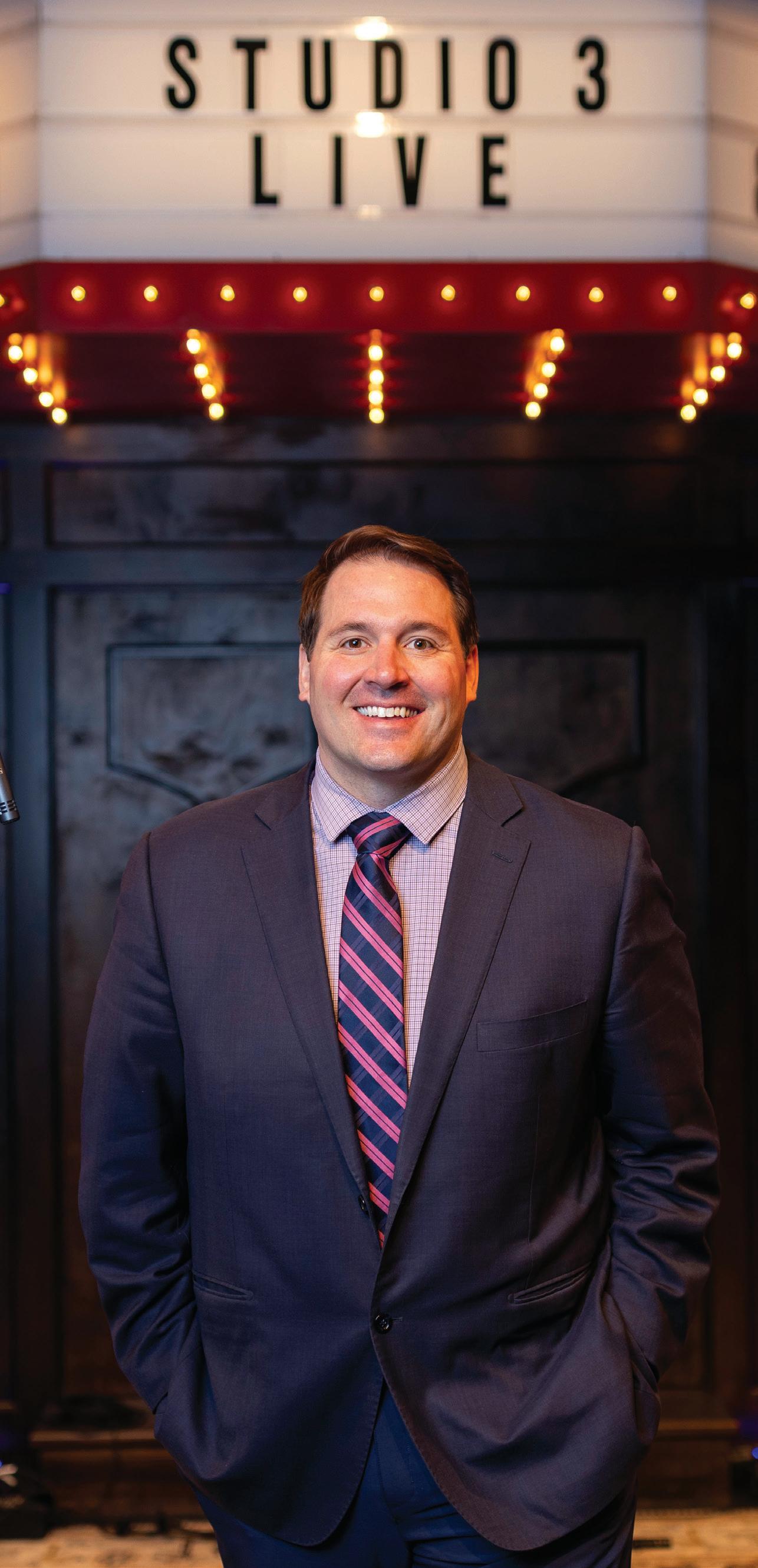
Andrew Batt
Executive Director and General Manager at Iowa PBS
What started as a summer internship turned into a 20-plus-year career for Andrew Batt at Iowa PBS. Now, Batt (’06) reflects on his passion for public programming and the favorite stories he’s told along the way.
You have been a senior producer on award-winning projects that cover a range of important local topics. Is there a story or topic that you are most passionate about covering?
I’ve loved telling stories. Live events are more of an adrenaline rush, whether it’s sports or a political debate — those are interesting and key to broadcasting, but I’ve loved telling in-depth stories in a documentary format. Whether that’s political history about former governors and presidential candidates or nature documentaries, anything that’s in-depth and involves storytelling is one of my favorite experiences as a professional.
Do you have a favorite documentary or series from PBS? I’ve always been interested in politics and history, and that came together in one project I did about 10 years ago, “Caucus Iowa: Journey to the Presidency.” It ended up winning an Upper Midwest Emmy Award. To me, the value wasn’t just in the final product; it was in the journey to make the documentary. I had a chance to travel across the country and meet with former presidential candidates, people who covered those races, and key staff who ran those presidential campaigns. It was a fascinating experience to do the research, dig through archives, and then interview these historical figures.
With the ever-evolving nature of the news and media industry, why is it important to you to maintain and grow public programming?
As a public broadcaster, we serve the entire state of Iowa. When I was a journalism student 20 years ago at Iowa State, there were far more publications and people in those careers in communities in the state who told stories. There are far fewer today. The need to have stories told as a service to a community is as strong today as it was 20 years ago. So, when I look toward the future and what Iowa PBS’ role is — it’s covering the state, its history, and the stories of today in a way no one else does.



Image by Isaac Farner
